






The political convention could cast the city in a bright light — or leave it with a black eye | PAGE
A Florida-based rm is exploring whether to become the primary nancial backer of Sterling Bay’s stalled $6 billion campus project
By Danny EckerA Florida-based real estate investor is kicking the tires on a plan to bankroll Sterling Bay’s Lincoln Yards megaproject on the city’s North Side, a potential breakthrough in the Chicago developer’s e ort to jump-start the stalled $6 billion development.
Boca Raton, Fla.-based Kayne Anderson Real Estate is exploring the prospect of becoming a primary nancial backer of the planned 53-acre campus and recently met with top Chicago planning o cials to discuss the project, according to people familiar with the matter. Sterling Bay has spent much of the past year hunting for a new nancial partner for the 14.5 millionsquare-foot development, which would reshape a swath of the city’s North Side between Lincoln Park and Bucktown with high-rises and generate thousands of new jobs.
It’s unclear how close Sterling Bay and Kayne Anderson may be to nalizing a partnership for Lincoln Yards, or how much money Kayne Anderson would contribute to the project. Sterling Bay disclosed the scale of its nancial need last summer when it made a pitch to the Chicago Teachers’ Pension Fund about backing the project, hoping to win an investment of as much as $300 million.
See LINCOLN YARDS on Page 20
BEER BUZZ
Illinois craft breweries are venturing into the murky waters of THC. PAGE 3


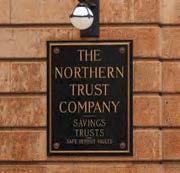
The National Association of Realtors’ decision could bring the industry back to the era before buyer representation became commonplace
e process of buying and selling a home is poised for a signicant overhaul in the coming weeks, months and years under a settlement agreement announced by a powerful trade group.
At the heart of the proposed settlement announced March 15 by the Chicago-based National Association of Realtors is a wholesale change in the commission structure for Realtors that could bring the industry “full circle” back to the era before buyer representation became commonplace roughly 40 years ago.
There’s at least some general consensus among real estate industry experts that buyers and sellers of homes will still pay Realtors, but the period in which 5%-to-6% commissions paid by sellers and split between the two agents seems to be on its way out.
And with that change could emerge a plethora of other shifts in the industry, ranging from a potential decline in the ranks of the nation’s roughly 1.6 million licensed Realtors to some drop in home prices.
Top of mind for Brian Connolly, an assistant professor of business law with a focus on residential real estate at the University of Michigan’s Stephen M. Ross School of Business, is the potential for a vastly diminished number of Realtors focused on representing buyers.
Simply put, in the age of Zillow and Red n — which have essentially put multiple listing services in the public domain — the role of buyer’s agents could be diminished signi cantly.
“I think you’re going to see a diminished role (for buyer agents),” Connolly said. “Where buyer’s brokers still exist, I think they’re going to need to double down on sort of proving their value.”
at could mean going from a sales-based commission compensation structure to more at fees, and brokerages o ering more of an a la carte menu of service o erings ranging from white glove, full-service to bare bones administrative help with the more technical aspects of home transactions, such as escrow and closing.
Dan Gutfreund, a Realtor with Signature Sotheby’s International Realty in Birmingham, said he expects to see more “dual agency,” in which buyers contact a seller’s agent directly and that Realtor winds up working both sides of the transaction.
Such a practice was common in the 1980s and before when buyer representation became commonplace.
“It’s kind of come full-circle,” said Gutfreund, who primarily works as a listing agent at the higher end of the market in suburbs including Birmingham and Bloom eld Hills.
Gutfreund said that given the afuent nature of most of his clients and the buyers who emerge for those properties, he expects that both sides of the deals he works on will generally continue to have professional representation.
Such transactions generally require high levels of creativity and work on the nancing aspect of high-end real estate, he said.
e changes planned by NAR, among the largest and most powerful trade associations out there, come as part of a settlement that would have the organization paying $418 million to end litigation that plainti s have said amounts to collusion aimed at keeping commissions for Realtors considerably higher than most of the rest of the world.
e NAR would not admit any wrongdoing as part of the proposed settlement, which still requires court approval.
A key proposal of the NAR settlement would disallow a seller’s agent from advertising a commission gure to buyer’s agents in the MLS. Going forward, commissions will likely be negotiated on a deal-to-deal basis, sources said.
As Axios reported March 18 morning, the overall changes to the commission structure could mean an end to what some have viewed as an inherent con ict of interest — largely disputed by the Realtor community — in which agents for buyers steer clients toward higher-priced homes, o ering larger commissions.
Local real estate executives, however, are quick to note that the proposal by NAR is far from the end of Realtor commissions.
“ e wild headlines that real estate commissions are over with are 100% (untrue),” Andrea Carollo, a Birmingham-based agent with Max Broock Realtors, wrote in an email to Crain’s on Monday.
“While certainly this settlement will make for change in the industry, ultimately buyers & sellers will still want their own representation and the bene ts from services that real estate agents o er.”
Under the long-held standard o ered by the NAR with regards to Realtor commissions, home sellers have traditionally paid the commission of the buyer’s agent (typically 2%-to-3% of the sales price), but that commission fee has generally been baked into the nal price of the home.
e model has allowed for
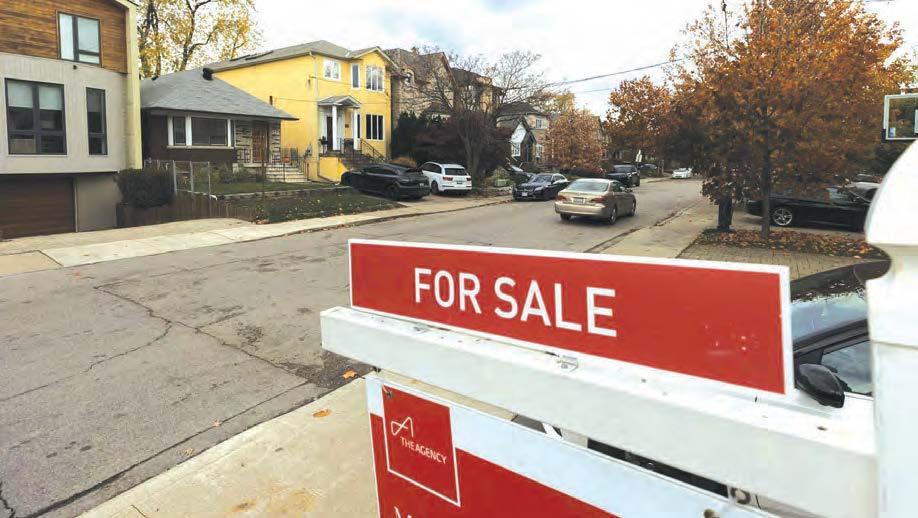
homebuyers to bake the Realtor compensation into their loan.
Going forward, a similar model is likely to emerge, according to Jeanette Schneider, president of Troy-based brokerage Re/Max of Southeastern Michigan.
“Looking ahead, we do not anticipate buyers will have a desire to come up with more money out of their pocket when buying a home,” Schneider wrote in an email to Crain’s. “Instead, we anticipate that the seller paying the buyer's agent commission will become a concession included in the purchase agreement, like other items that can be negotiated.”
Perhaps the biggest lingering question out there is whether the NAR changes will bring about a
reduction in home prices. On that question, experts Crain’s spoke with are somewhat mixed.
Realtors around the country receive a total of around $100 billion in total commissions, and that number could be cut by around 30%, the Washington Post reported last week.
But the current market forces — both locally and around the country — of limited inventory and relatively strong demand means prices will likely remain elevated, according to Schneider with Re/Max.
“ e limited inventory of homes for sale restricts the options available to buyers, leading to more intense competition,” Schneider wrote. “As long as this dynamic continues, we anticipate upward
pressure on prices.”
Connolly, the U-M professor, largely agreed.
“Does this mean that all of a sudden you’re going to see a 3% (decline) in home prices because all of a sudden people aren’t paying broker fees? Probably not,” Connolly said.
“We’re in a really, really supplyconstrained housing market. ere’s low inventory out there, there’s not a ton of new construction,” he continued. “In a perfectly elastic market, you might see that type of decline in home prices. It seems like it’s going to take some time for the market to sort that out.”
Nick Manes writes for Crain's sister site Crain's Detroit Business.


Some of the state’s brewers, still struggling to survive the pandemic’s aftereffects, see the infused drinks as a lifeline despite their ambiguous legality |
By Ally MarottiThere’s a new item appearing on tap lists at craft breweries around Illinois: THC-infused beverages. e state’s craft beer industry has struggled since the pandemic. Ten percent of the state’s breweries have permanently closed in the past two years as taproom tra c failed to return to pre-pandemic norms and consumer drinking habits changed. e survivors are looking to THC-infused drinks as a lifeline.
“Consumption of beer has been declining. . . .(We) have to continue to nd di erent channels of revenue or innovation,” said Mike Condon, co-owner of Noon Whistle Brewing. “We’re all looking at it as
See BREWERIES on Page 22
“It’s another way to be welcoming to folks who may not be drinking as much.”
Hopewell Brewing co-founder Samantha Lee
The din on Cboe’s trading floor is growing louder even as the volume in trading pits around the rest of the world is getting quieter.
at’s because of the strength of the Chicago-based exchange’s massively popular S&P 500 index options contracts, which investors use to mitigate their risk exposure in nearly every asset class and investment vehicle.
e hands-on environment works best for large trades, traders say.
“The floor environment is really conducive to the types of trades that happen in the S&P 500 index options,” said Catherine Clay, global head of derivatives at Cboe. “A lot of those types of trades require price discovery because they are multilegged strategies. They need a little bit of white glove service and handling.”
Around 300 traders populate the Cboe floor daily, barking at each other as they flash hand signals across pits to execute orders as they come in, standing in stark contrast to the decades-long migration to screens that account for the bulk of securities trading worldwide.
Cboe floor traders handle around 20% of the total trading in the exchange’s proprietary S&P 500 index options, its most popular contract. That amounted to about 660,000 pit-traded contracts a day during the first two months of 2024, Cboe said.
Pit trades account for about 45.5% of the volume, around 322,000 contracts daily, in Cboe’s volatility index options.
“This is what distinguishes our floor environment vis-a-vis the other exchanges, is really our proprietary index options complex,” said Clay.
Around 300 traders populate the Cboe oor daily, barking at each other as they ash hand signals across pits to execute orders as they come in.
Jason Coogan, a floor trader for Simplex who has been working in the S&P 500 index pit for more than 20 years, says the open outcry system is still the best way for institutional investors to get large orders filled.
“While they might get a slightly better price for a couple of hundred contracts, a lot of these customers want to get bigger quantities done, and the pit itself provides way more liquidity,” Coogan said. “I don’t see anybody wanting the S&P outcry pit to go away. I think it provides way too much value.”
Coogan’s point was proved
See CBOE on Page 22
Compasspoint Development has three residential projects in the pipeline as demand and rents for suburban apartments soar
Rachel HerzogA local developer plans to add nearly 400 luxury units to the Chicago area’s apartment stock, capitalizing on soaring demand and rents in the suburbs.
Barrington-based Compasspoint Development has three residential projects in the pipeline in the northwest suburbs of Barrington, Arlington Heights and Des Plaines. e rm plans to begin construction on a sevenstory, 131-unit building at 622 Graceland Ave. in Des Plaines this summer, with a six-story, 135-unit development at 116-120
W. Eastman St. in Arlington Heights and a four-story, 125unit complex at 200-300 N. Hough St. in Barrington to follow. ose projects will likely be delivered at a time when few apartments are projected to be built in the suburbs due to high construction costs. Suburban Chicago’s apartment stock was virtually full at the end of 2023, with overall occupancy at 97.3%, according to data from the Chicago o ce of appraisal and consulting rm Integra Realty Resources.
“ e demand is outrageous,” Compasspoint Development
managing Member Joe Taylor said.
A 212-unit apartment complex that Compasspoint completed at 1425 Ellinwood Ave. in Des Plaines is 97% occupied after opening in 2022, Taylor said. at development has also bene ted from the suburb’s strong rent growth, with the monthly rent for an approximately 600-squarefoot studio apartment hitting $2,000, on par with a typical, slightly smaller upscale studio in Chicago. Compasspoint’s upcoming projects will likely be
See DEVELOPER on Page 22

For CEO Marianne Markowitz,
just providing them capital won’t cut itMark Weinraub
Marianne Markowitz, CEO of First Women’s Bank, is encouraging her small clients to think big. e head of the Chicago-based bank that makes capital available to businesses with a strategic focus on the women’s economy says that too often borrowers are shortchanging themselves when it comes to prospects for the growth of their business.
“When we were launching, back when we were raising capital, we noticed with many people that we would talk to, they would say, ‘Oh you are starting an institution to support women. Well it must be a microlender,’ and we were like . . . ‘It is going to be a bank,’ “ Markowitz said in an interview. at attitude extends even to business owners as well, according to Markowitz, who said women own 50% less equity in their enterprises than their male counterparts.
“We noted that so many people in their head, their vision of the women’s economy is microenterprise,” she said. “We try to treat our small businesses like they are middle market.”
One of First Women’s custom-
ers, Kate Vrijmoet, used a $350,000 loan to help open a second location of her Necessary & Su cient Co ee shop in the Printer’s Row neighborhood.
“I knew I would need funding,” Vrijmoet said. “As a woman in business, I was trying to get funding from the start, and it was not available to me. I had been rejected or downsized from so many di erent programs that I just did not think there was any hope.”
Vrijmoet said that other banks rejected her outright or o ered her funding well below what she was seeking. One bank even asked for her husband’s nancial information even though he was not involved in the business.
e average loan size at First Women’s is $1.2 million, Markowitz said.
Ahead of its opening in 2021, First Women’s, which has 33 employees, raised nearly $40 million in funding. It also receives support through its corporate mission partners — companies that deposit between $1 million and $10 million at the bank.
Early corporate partners included William Blair, Aon, United Airlines and the Western Golf Association. First Women’s announced earlier this month that Ariel Investments, TransUnion and Lenders Cooperative also joined the roster.
“We knew we couldn’t do this alone,” Markowitz said. “We really built the bank around partner-

ships. ese companies, they don’t bank with community banks. ey are making a very intentional move to bank with us to support the mission.”
Just 37% of women in the United States say they are making real nancial progress, 12 percentage points less than men, according to a survey by BMO, Chicago’s second-largest bank by deposits.
e gap in Chicago is even starker, with only 32% of women in the area reporting that they are making progress compared to 49% of men.
“Broadly, we know there is a disproportionate impact of rising costs of living on women. at kind of re ects on the systemic
disparities and the economic inequity,” Tina DeGustino, BMO’s consumer strategy expert, said in an interview. “ ere is also the piece that they shoulder more family-related expenses, and that kind of leads to heightened nancial insecurity.”
BMO’s survey also showed that 67% of women experience nancial anxiety from keeping up with monthly bills, compared to 60% of men. In Chicago, those gures are 70% for women and 58% for men.
“Gender equity in many areas took a big step backwards as a result of the pandemic,” Markowitz said. “Certainly, women-owned businesses took a massive hit. We realized that not only do we have
a duty to grow the women’s economy and support it, but to tell the story of it.”
Jessyca Dudley, founder and chief executive of philanthropy rm Bold Ventures, used First Women’s to get a mortgage on an o ce in Ravenswood for her three-year-old company.
“ ere was certainly no other bank that really understood what it meant to be a female business owner,” Dudley said “With the other banks I talked to, it was really about the (pro t and loss) and the balance. For First Women’s, of course that’s important, but it was a lot more than that. It was a real thought about being a partner in the business as it is growing.”
The medical equipment maker is allocating $1.75 million this year toward improving maternal health outcomes around the globe
GE HealthCare, the Chicagobased medical equipment maker, is launching a charitable organization focused on advancing equitable access to precision health care, starting with the goal to improve maternal health outcomes globally.
e GE HealthCare Foundation, incorporated last August separately from GE HealthCare, will give cash grants to various nonpro t organizations using technology and innovative methods to make health care more accessible, personal and exible by removing barriers for underserved communities, according to the foundation.
is year, GE HealthCare put $1.75 million into the foundation, and grants will range from $400,000 to $600,000 each, said Danielle Halstrom, president of
the GE HealthCare Foundation and GE HealthCare’s chief communications and corporate marketing o cer.
Launching philanthropic arms is common for large, public companies. GE HealthCare’s Chicagoarea peers, including Abbott Laboratories and Walgreens Boots Alliance, have charitable organizations of their own.
Halstrom said the GE HealthCare Foundation chose to focus on maternal health issues initially because it’s an area that needs more support amid a severe shortage of primary care and midwifery professionals in the U.S. and around the world. Across the globe, a woman dies during pregnancy or childbirth every two minutes, according to estimates by United Nations agencies.
Further contributing to GE HealthCare’s focus on maternal health is that the company has

long manufactured medical devices, like ultrasound technology, which has become ubiquitous with maternal, pregnancy and fetal care.
“GE HealthCare operates at every point of care in the motherinfant journey,” Halstrom said.
“We have a long legacy in this area, and we thought this is where we would start and be able
to make a di erence.”
So far, the foundation has chosen four nonpro ts in which to invest, including e Urban Institute, a Washington, D.C.-based research organization focused on social and economic policy, and the Lwala Community Alliance, which is focused on addressing maternal and infant mortality in Kenya.
Other grant recipients include the Black Mamas Matter Alliance, an Atlanta-based network of Black women-led and Blackled birth and reproductive justice organizations and professionals, and Project ECHO, an Albuquerque, N.M., nonpro t focused on improving the public health workforce in Indonesia.
Each organization will receive grants in April, Halstrom said.
Aside from issuing grants, the GE HealthCare Foundation will provide aid for humanitarian relief during times of natural disasters and crises.
GE HealthCare joined the ranks of Chicago’s largest publicly traded companies last year when it spun o from General Electric. In its rst full year as a stand-alone entity, GE HealthCare reported $1.6 billion in 2023 pro ts on more than $19.5 billion in sales.
“We’re really proud to be launching this foundation so quickly after we spun out from GE as an independent company,” Halstrom said. “It was just really important for us to start our philanthropic legacy.”

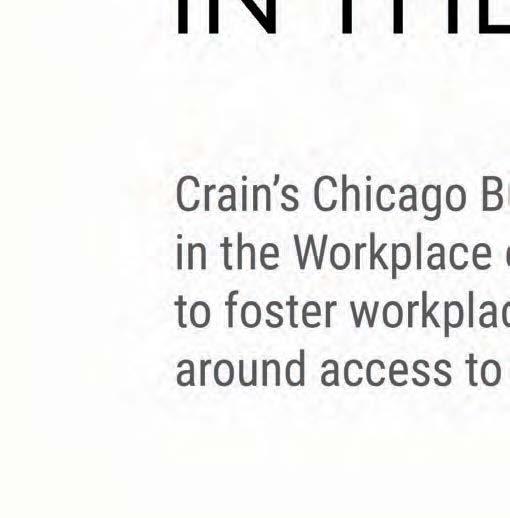



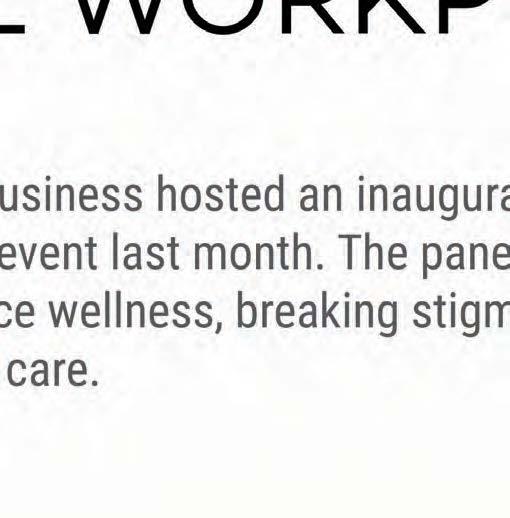








Crain’s columnist Greg Hinz declared the rst week of this past December as Chicago Mayor Brandon Johnson’s “terrible, horrible, no good, very bad week.”
When historians someday write the book on the Johnson administration, however, the week of March 18 may vie for that particular honor.
You’ll recall — though the mayor would likely prefer not to — that the ill-fated December week in question was marked by a public brawl with Gov. J.B. Pritzker over the plan to build a migrant encampment on what proved to be toxic land in Brighton Park. Then there was the exodus that same week of three veteran execs from the city’s corporate recruitment agency, World Business Chicago. The cherry on top that week came in the form of Ald. Jeanette Taylor’s explosive interview with political journalist Ben Joravsky, in which she declared progressives are “not ready” to govern Chicago.
Fast-forward to this month — and the March 19 primary election:
First, “Bring Chicago Home,” a pillar of the mayor’s progressive agenda, went down to a fairly resounding defeat with a margin of 54% “no” to 46% “yes” on election night, as voters rmly rejected the mayor’s pitch to fund ill-de ned antihomelessness goals by hiking transfer taxes on high-end property sales. ough mail-in ballots are still being counted even now, the writing was on the wall early that evening: It would take an overwhelming percentage of the outstanding ballots for the needle to move in Johnson’s direction.
The next day, Johnson was clearly still smarting from the loss. In a feisty con -
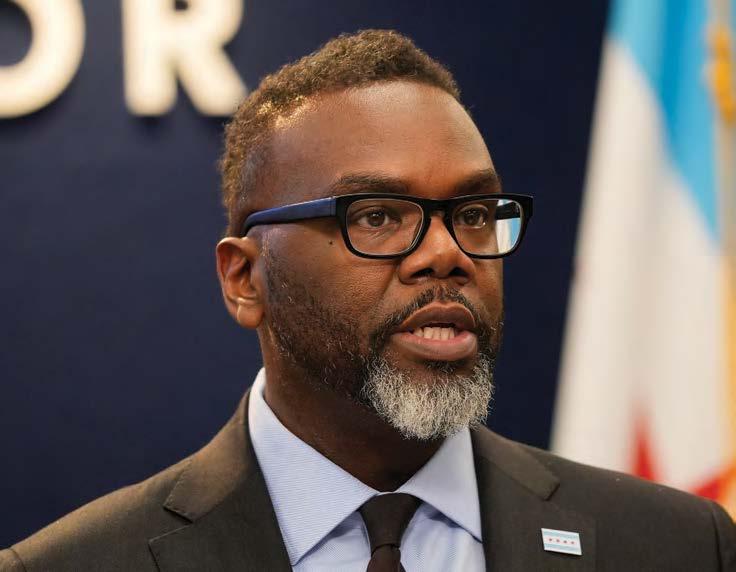
versation with the City Hall press corps, the mayor argued the city’s ethics rules had constrained his ability to “punch back” against Bring Chicago Home’s critics in the run-up to the vote. Which means the mayor expects Chicagoans to believe he could contribute cash to the Bring Chicago Home effort — his political account poured in $100,000 to the campaign — but he couldn’t speak on its behalf, nor could he designate anyone in his orbit to be the public point person on an issue that was a hallmark of his candidacy. His spokesman, Ronnie Reese, added that the mayor’s extensive schedule prohibited him from actively cam -
paigning. If only he hadn’t had that one arm tied behind his back, the mayor’s team suggested, Bring Chicago Home would have passed for sure.
“Heck yeah I wanted to be out there. at sucked, when you’re a gamer and you knock down shots and you can’t be out on the court. I wanted the ball, absolutely I wanted the ball,” Johnson insisted.
He went on to characterize Bring Chicago Home’s opponents as “cowardly, cowardly,” repeating previous insinuations that those who worried about the e ects of the transfer tax on the central business district don’t care about home-
less people. Statements like that might re up the ranks when you’re a union organizer, but they have a di erent e ect when you’re the mayor. Politics is about persuasion, and shaming people who see the world di erently isn’t a terribly e ective way to win them over — or to get them to hand you a blank check. Homelessness is a very real problem that demands comprehensive solutions. If Bring Chicago Home was the answer, it was up to Johnson & Co. to convince voters of that fact. ey failed. at doesn’t necessarily make the opposition cowards, nor does it make its supporters heroes.
e remainder of the week brought more bad news. On the day after Johnson’s spirited press conference, his chief of sta , Rich Guidice, quit, though City Hall insiders insisted his exit was a long time coming and wasn’t tied to the Bring Chicago Home drubbing. Veteran pols and members of the City Council described Guidice’s role as becoming tenuous under Johnson in recent months as he’d been left out of important meetings where a chief of sta would traditionally be included.
And closing out the week was a Bloomberg story recapping much of what Crain’s has previously reported on the deceleration of the O’Hare International Airport revamp, a critical economic development project that’s projected to be billions over budget and for too long has been nowhere near the top of the mayor’s priority list.
So it was another week for the record books in Johnsonland. e trouble is, when the mayor has a terrible, horrible, no good, very bad week, the rest of the city does, too.
In September 2023, a diverse, femaleled ownership group purchased the Chicago Red Stars after a tumultuous chapter in the club’s history. Our respective backgrounds in professional sports, finance, turnaround management, commercial real estate, marketing and advertising, paired with our deep community ties, make for a powerful combination that will serve us well in reaching our ultimate goal in building a world-class championship organization on and off the pitch.
We are seeing unprecedented growth in the National Women’s Soccer League. e NWSL saw record-breaking attendance last year, announced new media partnerships including CBS Sports, ESPN, Amazon Prime Video and Scripps Sports, and
will be adding two new franchises in 2024. Women’s soccer has seen progress, but we have a long way to go in achieving equity.
The issue of equity in sports is now front and center, from the U.S. National Soccer Team to college sports to our professional athletes.
It is exciting to see there is discussion about potential new stadiums on the horizon for the Chicago White Sox and the Chicago Bears. Sports teams have the power to catalyze economic development in a community with investments in projects like stadiums and
training facilities, while also uniting communities by creating a sense of civic pride and inspiring young people to get active and involved in sports. It is critical that women’s sports are included in these important discussions moving forward.
e issue of equity in sports is now front and center, from the U.S. National Soccer Team to college sports to our professional athletes. e unfortunate reality is that women’s sports teams are often relegated to secondary elds or sharing facilities with men’s sports. Many times, they nd themselves practicing in subpar facilities, such as a high school stadium, where playing conditions lead to injuries.
All women’s sports deserve support, but the Chicago Red Stars in particular need to plan for a stadium and a practice eld.
Mayor Brandon Johnson is a tireless ghter for diversity, equity and inclusion, and has achieved many historic accomplishments in less than one year as mayor of our city. We applaud his e orts and ask that he include women’s sports teams in his mission of equity for all.
A true commitment to equity means that women’s sports have a seat at the table when there are discussions about public/private partnerships to build the next generation of sports stadiums.
This is a historic opportunity for Illinois leaders to make a major statement that women in sports are just as important as men’s sports.
The article “For hospitals, largely exposed to cyberattacks, Lurie demonstrates how bad it can get” (Feb. 20) sheds light on the increasing threats organizations face in the realm of cybersecurity. As a cybersecurity incident response expert, I feel compelled to emphasize the critical importance of having a comprehensive incident response plan in place for organizations across all sectors.
e recent cyberattack on Lurie Children’s Hospital serves as a stark reminder no sector is immune to the evolving and sophisticated threats in the digital landscape. From health care to manufacturing, nance to legal, organizations must recognize they are all potential targets. It is imperative for businesses to proactively address this threat landscape by establishing and regularly updating a robust incident response plan, or IRP.
An e ective IRP is not a mere precautionary measure; it is a strategic necessity. Having a wellde ned plan can make the di erence between swift recovery and prolonged disruption. is is particularly crucial in sectors like health care, where the stakes are high and patient data security is paramount.
A comprehensive IRP should encompass not only the technical aspects of cybersecurity but also the coordination of people, processes and communication channels. Regular testing and updating of the plan are essential to ensure its e ectiveness in the rapidly evolving landscape of cyber threats.
Beyond technical considerations, it is vital for organizations to foster a culture of cybersecurity awareness among their employees. Education and training
LAURA RICKETTS, Chicago Red Stars executive chairperson
KAREN LEETZOW, Chicago Red Stars president
SOFIA ANASTOPOULOS, executive director of the Illinois Metropolitan Investment Fund
ANGELA E.L. BARNES, chief legal o cer at Ideo
DR. TRACI P. BECK
DEBRA CAFARO, chairman and CEO of Ventas
LAURAN DESMOND, chair and CEO of Smartly.io
SIDNEY DILLARD, investment banker and partner at Loop Capital Markets
JESSICA DROSTE YAGAN, partner and CEO of Impact Engine
MEGAN MURPHY, owner of LaCrosse Milling
EDITHA PARAS, nonpro t executive
COL. JENNIFER N. PRITZKER, Illinois Army National Guard (retired) and founder of Tawani Enterprises
HILARY ROSEN, strategic communications consultant
programs can empower sta to recognize and respond to potential threats, serving as an additional layer of defense.
e nancial implications of a cyber incident cannot be overstated. e cost of recovering from a breach, both in terms of monetary losses and damage to reputation, can be devastating. Investing in a proactive and robust incident response plan is a prudent step that pays dividends in mitigating these risks.
e Lurie cyberattack serves as a wake-up call for all organizations,
regardless of sector. Cybersecurity threats are pervasive and the need for a comprehensive incident response plan is non-negotiable. By prioritizing preparedness, organizations can position themselves not only to withstand cyber threats, but also to recover swiftly and resume normal operations.
It is time for businesses to recognize a proactive stance against cyber threats is an investment in their long-term resilience.
DAVE SMOLENSKY Partner Resolute Strategic Services


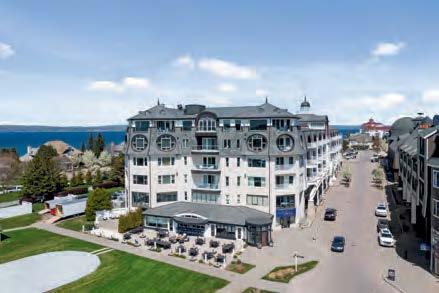

Amalgamated Bank of Chicago, Chicago
Chicago State Foundation, Chicago
Elliott & Associates Attorneys PLLC, Des Plaines
IMD Guest House Foundation, Chicago

Aaron Beyers joined AECOM’s Chicago of ce as an Associate Principal and Architecture Design Lead. With almost two decades of experience, he is responsible for navigating the design, management and coordination of multidisciplinary teams. At AECOM, Aaron leads a collaborative design process that marries ideology, and technical precision while evoking the strengths of the larger project team.
Jahn, Chicago
Amalgamated Bank of Chicago is proud to announce that Timothy Clifford has been promoted to EVP & Chief Financial Of cer.

Tim has been with ABOC since 2022 and is responsible for all accounting, nancial reporting, budgeting, and tax issues for the Bank. He serves as a member of ve Committees, including the Bank’s Senior Executive Management Group. Timothy has more than 25 years of nancial, operational, and compliance audit experience, of which 15 have been in leadership roles.
Chicago State Foundation announces Andre Baker, Executive Director and Market Director at JPMorgan Chase, and Jason Mercer, Principal at Cleveland Avenue, CAST US Fund, as newly elected members of the Board of Directors.



Scott Seyer, AIA, LEED AP, has joined Jahn as a managing director, returning to the rm where he started his career. He brings to Jahn more than 28 years of professional experience designing large-scale projects around the globe, including highpro le of ce projects, multi-family, mixed-use developments, and higher education buildings. Through this role, Seyer will be part of the collaborative leadership team responsible for leading the rm’s domestic and international growth.
First Bank Chicago, Northbrook
Associated Bank, Chicago
Drew Lear has joined Associated Bank’s Chicago Commercial Banking team as Senior Vice President -Relationship Manager. He is responsible for relationship management and business development for middle market commercial clients. Drew brings more than 16 years of banking experience to Associated having previously held positions at Capital One and Bank of America Merrill Lynch. For the last nine years, Drew has been on the Chairman’s Advisory Council for the Big Shoulders Fund.

Baker oversees 16 branches across the Chicago area, including the top 10 most diverse communities in Illinois. He was instrumental in creating a partnership between JPMorgan and Chicago State University, creating a pipeline for graduates to ll open positions with diverse talent. Mercer supports, via investment, Black, Brown and Women entrepreneurs, primarily in Chicagoland. Mercer has over ten years of experience in strategy, nance, and mergers and acquisitions-related roles within large, multi-national organizations.
The Joint Commission, Oakbrook Terrace


First Bank Chicago, one of the top 5 privately held banks in Chicago, congratulates Tom Neylon on his recent appointment to the Board of Directors at Center for Advancing Domestic Peace. Tom, SVP Middle Market Banking, is one of many employees giving time, talent and resources to our community and neighbors as part of our bank-wide culture of caring. We applaud Tom’s contributions to the Center for Advancing Domestic Peace in meeting their mission to stop domestic violence where it starts.

Republic Bank of Chicago, Oak Brook
Republic Bank, serving Chicagoland since 1964, is pleased to welcome

Adam Brook as Executive Vice President and Chief Operating Of cer. Adam brings nearly twenty years of in-depth operations experience to the Bank’s leadership team, with an extensive background in commercial and consumer lending. Further, his experience overseeing the daily business operations of IT, Facilities, Security, Loan & Deposit Operations, and Enterprise Risk Management teams has contributed to his ability to support Republic Bank’s infrastructure and growth plans while upholding a sound risk management framework. He received his Bachelor’s degree in Marketing/Management from DePaul University.

365 Equipment & Supply, Des Plaines
Bryan Olson has been promoted from COO to President, 365 Equipment & Supply.

With more than 20 years of experience leading B2B sales and operational excellence in Fortune 100 companies, Olson has doubled the organization’s revenue since joining the rm and earned recognition in the Webb Analytics 150 supplier report for the highest year-over-year growth in the building materials sector. 365 Equipment & Supply’s broad range of supplies, materials and equipment, their dedication to customer service, and competitive pricing, make them the ideal partner for successful construction projects.

Lakeshore Financial Group, Chicago
The Joint Commission proudly announces that Carla Pugh, MD, PhD, professor of surgery at the Stanford School of Medicine and director of the Technology Enabled Clinical Improvement Center at Stanford Medicine, has been selected as inaugural fellow for its President’s Fellowship for Healthcare Quality and Safety, a prestigious program for a highly quali ed healthcare professional to collaborate with The Joint Commission to advance healthcare outcomes globally.
Croke Fairchild Duarte & Beres LLC, Chicago

Croke Fairchild Duarte & Beres is pleased to welcome Samantha Nunez to the rm as an associate in the public nance practice group. Prior to joining the rm, Samantha spent more than 10 years working for the Metropolitan Water Reclamation District of Greater Chicago. She also has experience litigating civic matters in both state and federal court.

LAW FIRM
Pilgrim Christakis LLP, Chicago

Welcoming Zach Perez, LSFG’s newest Managing Director, bringing over 10 years of nancial experience. He most looks forward to leveraging his nancial, sales, and marketing experience and expertise to drive growth, cultivate strong relationships both internally and externally, and contributing to the continued success and expansion of the rm. Zach joins from the Mutual of Omaha.

Elliott & Associates is proud to announce the elevation of Lauren C. Elliott to Partner. Before Elliott & Associates Lauren practiced in civil litigation with a prominent personal injury and defense rm. Lauren currently represents property owners before the Cook County Assessor, Cook and collar county Boards of Review and the Property Tax Appeal Board. She exceeds client expectations every day with her client rst mentality and ability to achieve the fairest possible outcome for her clients.


Elliott & Associates Attorneys PLLC, Des Plaines

Elliott & Associates is proud to announce the elevation of Melissa K. Whitley to Partner. Melissa has over 20 years’ experience in representing property owners before the Cook County Assessor, Cook and collar county Boards of Review and the Property Tax Appeal Board. She amazes clients every day with her positive attitude. Melissa has also successfully obtained real estate tax incentives and exemptions for numerous clients saving them hundreds of thousands in real estate tax dollars.

In anticipation of the 2024 Chicago Street Race Weekend July 6-7, Alexandria Munoz has been named Managing Director, Head of Commercial Revenue for the NASCAR Chicago Street Race. A Chicago native, Munoz brings an extensive portfolio of corporate partnership and business development experience to NASCAR, having worked in the MLS, NBA, Lear eld, MLB, and others. Most recently, she served as Vice President of Corporate Partnerships for the Chicago Fire.
STAFFING / RECRUITING
Addison Group, Chicago


Guest House is pleased to promote Art Sims to Community Outreach Manager, a newly created position. With 30+ years of experience in journalism including work at Weigel Broadcasting, The Chicago Defender, and Midway Broadcasting, Art joined the Guest House staff in 2022. He is active in various advisory boards such as Disability Lead 2019 Fellow & Ambassador, Chatham Park Village Cooperative, The Chicago ADA Advisory Committee of Pace, and American Heart Association of Metro Chicago Health Equity Advisory. He was inducted into Who’s Who in Black Chicago and was honored by Monarch Magazine as a trailblazer in media. Guest House is a 501(c)(3) nonpro t that provides temporary lodging to medical patients seeking treatment in Chicago.



Fort Dearborn Partners, Inc., Chicago FDP proudly announces the elevation of Rob Cleary and Mark Kroeger to Shareholders. Since 2011, Rob has rapidly progressed from Consultant to Senior Director and become integral to the growth of the rm’s Consulting and M&A practices. As a Shareholder, Rob will focus on developing and growing the rm’s business and have primary oversight of FDP’s Investment Banking practice.
As a Shareholder, Mark will play a critical role in FDP’s growth and continued success by focusing on developing staff and business strategies that take advantage of the rm’s immensely talented team’s broad set of skills and experience. Mark’s experience, leadership, and organizational skills will enhance the structure and consistency of each engagement.

STAFFING / RECRUITING

Pilgrim Christakis LLP, a Chicago-based nancial services litigation boutique, has announced the promotion of Alan Ritchie to partner. Alan has been with the rm for 5 ½ years, representing the consumer nancial services industry in courts and arbitrations around the country in consumer protection, data privacy and commercial disputes. Alan earned his undergraduate degree from Northwestern University and his Juris Doctor degree from Loyola Law School, Los Angeles.
Addison Group is excited to announce Emily Montgomery as a quali er for the Manager of the Year award for 2024. Her performance as Branch Manager for our Human Resources Talent Solutions (HRTS) division in Schaumburg, IL has proven exceptional. Emily Montgomery Specializes in HR Talent Solutions, Providing Interim, Consulting, Project-based, and Permanent-Hire HR Workforce Placement Solutions.



Brilliant Staf ng, LLC, Chicago Brilliant ® welcomes back Doug Lowery, one of the original ve founders, as Chief Revenue Of cer. Doug will serve as the executive leader of business development and customer success, with a mission to spearhead Brilliant’s new customer acquisition strategy and expansion of existing client relationships. Most recently, Doug was the lead sales executive for Crowe LLP in the Chicagoland market. He achieved great success in this role for ve years before returning to Brilliant.
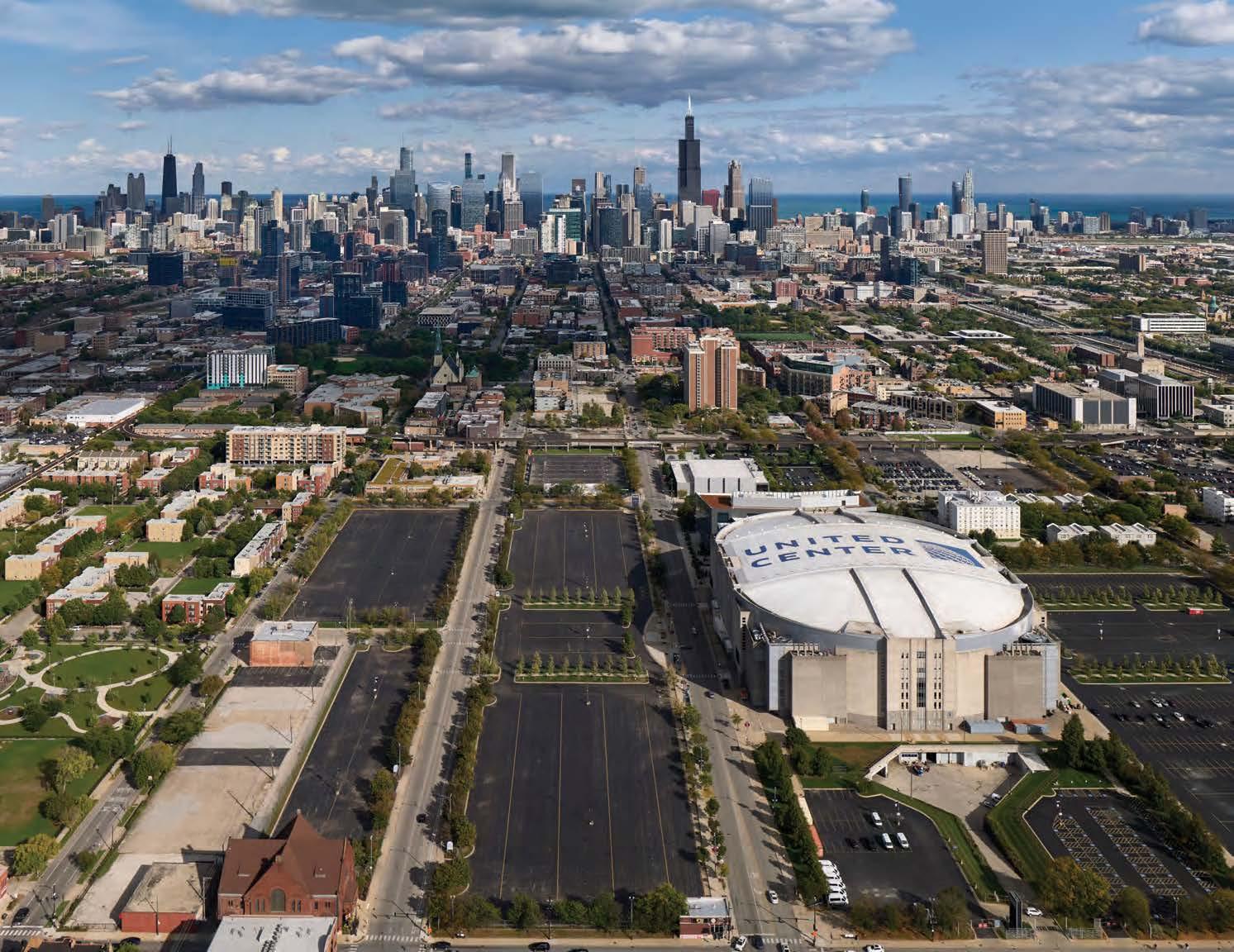
The political convention could cast the city in a bright light — or leave it with a black eye
| By Steve HendershotAnational spotlight will shine on Chicago in August when 50,000 visitors, including 15,000 members of the media, come to town for the Democratic National Convention.
e question is whether Chicago’s fourday star turn will prove to be a good thing.
“What’s at stake for us is being able to have a dramatic impact on our reputation and in reshaping our narrative,” says Rich Gamble, interim president and CEO of Choose Chicago.
Hosting a convention can indeed boost
perception of a city, as well as raise its prole. It happened in Cleveland eight years ago — the last time political conventions occurred in person — when e Atlantic declared “Cleveland won the Republican National Convention” and e Washington Post said “We were promised a riot in Cleveland. We got a block party instead.” In the wake of that convention, the number of people willing to consider traveling to Cleveland jumped from 33% to 38%, according to a survey from Visit Cleveland, a local tourism group.
But the stakes and circumstances are di erent for Chicago this year than they were for Cleveland in 2016, and for Milwaukee, which is hosting the Republican National Convention this summer. ose cities aspire to join the upper tier of U.S. convention and tourism hot spots — Chicago is already there.
“If you’re McCormick Place (the site of daytime DNC programming), this is not putting you on the map. It’s already a
SPONSORS
See DNC on Page 12 Chicago
isn’t a typical host city whose role is to provide a pleasant, passive backdrop. Instead, it’s a leading character in the election narrative.
From Page 11
premier destination,” says Victor Matheson, a professor at College of the Holy Cross who studies the economic impacts of hosting political conventions.
Instead, a convention win for Chicago means staving o the perception that the city is unsafe or that its downtown is in decline. It means demonstrating “that we’ve got our act together, that we’re still a city that works and truly a downtown that works,” says Michael Edwards, president and CEO of the Chicago Loop Alliance.
And that’s where it gets tricky — because some of Chicago’s perception problems are rooted in reality, and also because its role in this convention is uniquely political. For Chicago to bene t in the long term from the Democratic National Convention, it needs to provide a smooth convention experience and demonstrate that its strengths remain strengths and that its issues are under control.
How Chicago is different from typical host cities
U.S. cities in “purple” states that are up for grabs have hosted most national political conventions in recent election cycles, but Illinois doesn’t t that description. Instead, it’s a solid bet to vote for the Democratic nominee in November’s general election.
at means Chicago has a different appeal to Democrats: It enables them to “use the convention to draw a contrast” between their political vision and that of presumed Republican nominee Donald Trump, according to a spokesperson for the Democratic National Convention Committee.
rough a Democratic lens, Chicago is a vibrant, diverse city with strong union ties that stands as an example of what’s possible under the Democratic leadership of Mayor Brandon Johnson and Illinois Gov. J.B. Pritzker. Former President Trump, in contrast, famously and unfavorably compared the violence in Chicago to that of Afghanistan.
Chicago’s struggles are “denitely going to be weaponized by the Republicans — that you are in a ‘dangerous city,’ " says Heather Hendershot, a Northwestern University professor who studies political media coverage (and is unrelated to this story’s author). During the convention, “ e GOP is going to continue along that line. ey would attack any city that hosted the DNC, but Chicago seems to provide them a little bit more ammo.”
at means Chicago isn’t a typical host city whose role is to provide a pleasant, passive backdrop. Instead, it’s a leading character in the election narrative.
Chicago also appeals to Democrats because of the party’s legacy and infrastructure here. e location enables President Joe Biden to rea rm his close ties to former President Barack Obama, whose presidential center is under con-
When Chicago hosts the Democratic National Convention and its 50,000 attendees in August, the city will have a golden opportunity to reaf rm its standing as a marquee destination for tourism and events. But for Chicago’s reputation to bene t, the city will have to perform under pressure during the event.


2 Fulton Market
When Chicago hosted the DNC in 1996, Randolph Street was a major thoroughfare for media and delegates commuting from Loop hotels to the United Center — but “Restaurant Row” wasn’t yet a thing. This now-booming stretch will again be a key corridor during the 2024 DNC, with an opportunity to showcase Chicago’s strength and vibrancy.



1 The United Center
The televised portion of the convention will take place at this West Side arena. Protesters are planning to gather at nearby Union Park, making this area a potential ashpoint for clashes between protesters and security personnel.

struction in Jackson Park. And both Pritzker and Johnson are Democrats with national pro les.
“ ere is this marriage between the party — the DNC and the White House, along with the state and city — that we did not have” the last time Chicago hosted the event, says Leslie Fox, executive director of the host committee for the 1996 Democratic National Convention. “We were ful llers to a contract. We were not besties.”
At a normal convention, “when things go well, we tend to forget about the host city completely,” says Matheson of the College of the Holy Cross. is summer, however, Chicago is less likely to fade into the background. at means more pressure not only to avert disaster, but also to deliver a convention experience commensurate with a city that Democrats, both nationally and locally, hope exempli es the possibilities of progressive leadership.
Achieving that outcome is no slam dunk. First, Chicago is no stranger to the worst-case scenario of hosting the Democratic National Convention. at happened in 1968, when violent clashes between police, protesters and journalists gave the city a lasting black eye. While the political atmosphere this year doesn’t match the chaos of 1968, there’s perhaps more potential for conicts within the Democratic Party and protests than in a typical election year, because of such issues as the Israel-Hamas war and the migrant crisis in the U.S. Security for the convention is overseen by a coalition of federal agencies in coordination with Chicago police, but interactions between law enforcement personnel and protesters will be under a microscope, especially after city o cials struggled to handle racial justice protests in 2020.
Second, for Chicago to turn its convention showcase into a longterm bene t for its image, stand-
ing and economy, the city needs not just to survive, but also to show out. at means leaving visiting delegates and media with the impression of a city whose downtown is progressing in its pandemic recovery; with vibrant neighborhoods that demonstrate that Chicago is succeeding at spreading wealth and opportunity across the city; and with infrastructure that speaks both to livability and to the cohesion, competence and long-term vision of local leaders.
If you live here, you likely can imagine a convention experience that gets the job done — as well as one that doesn’t.
Many of the speci cs of Chicago’s e ort are still being worked out. Earlier this month, the host committee was still building its ofces within the Chicago Transit Authority’s West Loop headquarters.
But Chicago’s plans are taking shape, and it’s not too early to identify the key areas that will determine whether the city positions itself for a long-term, post-convention boost or muddles through an experience that’s either forgettable or, worse, unforgettably bad.
Leaders of a coalition of protest groups called March on the DNC 2024 expect thousands of people to join them at convention demonstrations in Union Park near the United Center. e city denied their permit requests, hoping protesters would agree to assemble at Grant Park instead, but coalition leaders say they’ll gather at Union Park regardless, because it’s important to be within sight and sound of the televised portion of the convention.
“I’m worried that this is going to back re because activists are going to show up anyway, and now it’s more likely to be confrontational,” says Karen Pita Loor, a Boston University law professor who studies protest policing.
3 Magni cent Mile
The iconic Chicago shopping district needs to show a national audience that it still shines brightly despite post-pandemic safety concerns and high vacancy rates.



4 The Loop and Millennium Park
Hotels in the city’s center will host many of the visiting delegates and media members, and the area also sits between the United Center and the DNC’s daytime home at McCormick Place. Will Chicago’s central business district signal that a post-pandemic rebound is in full swing, or give the impression of a downtown in decline?



“ e focus should really be on de-escalation and also making connections with organizers, and this was a missed opportunity.” e clash over location is a foreboding rst act in what city and Democratic leaders surely hope results in a clinic in how to honor the right to protest while also maintaining civic safety. Security e orts will be coordinated by a coalition of federal agencies working in conjunction with the Chicago Police Department, with local police receiving extra training on how to handle large-scale protests while planning to eschew riot gear. One meaningful di erence from the 2020 protests is that Chicago has since elected a mayor with a background as a protester and activist. Kobi Guillory, a spokesperson for the protest coalition, blames the violence that occurred during the 2020 demonstrations on decisions by thenMayor Lori Lightfoot’s administration to impose short-notice curfews and raise downtown drawbridges.
“We don’t expect anything like that from Brandon Johnson, because he’s from the movement and he cares about social justice. But there’s still the whole Chicago machine we have to contend with,” says Guillory.
Chicago’s city center, just like many of its peers across the country, continues to recover from the COVID pandemic. e Democratic National Convention presents a huge opportunity for tourist destinations like the Loop and the Mag Mile to remind visitors of their charm and viability — but they must do so while continuing to claw their way back. e Loop, for example, has a record-high 30% vacancy rate, according to the Loop Alliance’s Edwards.
e DNC also has the potential to attract additional large-scale conventions to Chicago. To that end, Choose Chicago, the city’s tourism arm, is planning to bring
potential clients to town immediately before the DNC to show o the city’s convention prowess — and the appeal of downtown as an after-hours destination is a crucial part of Chicago’s sales pitch.
e Chicago Loop Alliance is considering several strategies to spruce up the area ahead of the convention, ranging from enhanced landscaping to art displays inside vacant storefronts, as well as relocating a State Street visitor center from its current location within Macy’s to the street itself. “It’s essential that we keep the street vital and healthy looking,” Edwards says.
In 1996, the last time Chicago hosted the Democratic National Convention, attendees were encouraged to stick to a de ned footprint within the city. is time, the host committee is encouraging visiting media to pursue stories that include travel to all 77 Chicago neighborhoods — “from Rogers Park to Riverdale,” as host committee chair Christy George put it in an email to Crain’s.
If all goes well, that decision will turn national media onto the diversity, creativity and culture that de ne Chicago beyond downtown, and perhaps draw funding to initiatives aimed at revitalizing communities such as those near the United Center.
Groups located near the convention site already are making plans to capitalize on the attention. e Illinois Medical District’s leaders are accelerating plans to install new roadside signage and are considering whether programming such as live music or food trucks could draw conventioneers to visit its campus. And community leaders are excited about the prospect of showing o their e orts to delegates and media who might be able to steer additional funding their way.
“On the West Side, we have a renaissance happening right now,” says Ayesha Jaco, executive
director of nonpro t West Side United. “We could show how through this investment and shared commitment between local philanthropy, state and local government, and by partnering with and following the lead of the community — we can help revitalize communities.”
It’s a laudable mission, but it also means lots of activity beyond the o cial security perimeter to parts of the city that are struggling with ongoing violence.
Another pillar of the host committee’s early work is an e ort to ensure that local small businesses have an opportunity to share in revenue from the Democratic National Convention. at ranges from a vendor directory that highlights local and diverse businesses to the selection of Show Strategy, a Chicago-based, Black-owned rm, as a prime contractor.
“We’re trying to give the smallbusiness community the rst bite at the apple,” says host committee spokesperson Natalie Edelstein.
e Chicago Transit Authority will also be on display during the convention, both because the host committee plans to use CTA buses to ferry attendees to and from convention sites, and also because of those neighborhoodbased media stories that the committee plans to facilitate. at’s a lot of attention on a civic resource that’s taking heat for poor administration, unreliable service and high crime rates.
Chicago “has some of the best bones for transit in the nation, but right now the system needs intervention at the state and federal levels. What happens if these inuential folks nationally see a dysfunctional system?” asks Kate Lowe, an associate professor at the University of Illinois Chicago who specializes in transit. “People are giving up on (el trains) when they see how long the wait is. We have a real risk that that is also the experience delegates will have, instead of seeing what an asset transit can be and taking that message to their statehouses and to D.C.”
From the national Democratic perspective, the convention is a place to showcase party unity ahead of the general election — and to gloss over contentious intra-party issues such as the Israel-Hamas war and how to address the migrant crisis. Both Pritzker and Johnson are highpro le Democrats, but there are plenty of reports of a strained relationship between them, and they’ve been on opposite sides of the Israel-Hamas war. Could a public spat turn into a bad look for the city and party?
Not likely. For one, both politicians are likely to stick to the script during the convention. And even if they don’t, the consequences likely won’t be severe.
“I don’t think Pritzker and the mayor being on opposite sides of an issue or two is going to present any signi cant problem,” says Matheson, the College of the Holy Cross professor. e Democratic Party “is a pretty big tent and always has been.”
For more than a century, Chicago was the premier destination for national political conventionsBy Steve Hendershot

When Chicago hosts the Democratic National Convention this summer, it will mark the rst time since 1996 that the city has hosted a political convention, and just the third time since 1968.
But before that? For more than a century, Chicago was the premier destination for national political conventions. From 1860 to 1968, Chicago hosted 25 major party conventions over the course of 29 election cycles, more than any other city — 14 Republican conventions, 10 for the Democrats and one for the Progressive Party when it nominated former President Theodore Roosevelt in 1912.
Those conventions played a crucial role in forming Chicago’s reputation as a convention city. Here’s a look at a few of the most noteworthy.
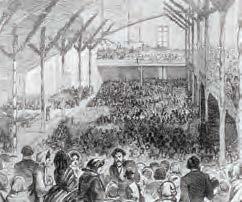
1860 Republican National Convention: The Republican Party, formed just six years earlier, met in a temporary structure called the “Wigwam,” located on Wolf Point by the Chicago River, a site where Chicago’s rst hotel, the Sauganash, burned down a few years earlier. William Henry Seward from New York was the front-runner for the nomination heading into the convention and won the rst of several rounds of voting. But the momentum turned against Seward, and the nomination — and, eventually, the presidency — went to downstate politician Abraham Lincoln.
1888 Republican National Convention: There was so much excitement about the Auditorium Building on Michigan Avenue, designed by Dankmar Adler and Louis Sullivan with help from Frank Lloyd Wright, that the Republicans held their convention there even though the building wasn’t nished. Two key technological innovations helped with the decision: The building featured air conditioning as well as electric lights that enabled evening sessions. The Republicans nominated Benjamin Harrison, who went on to win the White House.
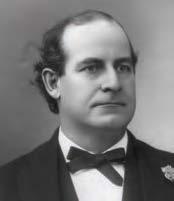


1904 Republican National Convention: Theodore Roosevelt became president in 1901 after the assassination of William McKinley, so this convention marked the rst time he earned the party’s presidential nomination. The convention venue was a historical oddity, built from the remains of a Confederate stockade that was transported from Virginia to Chicago after the Civil War and reconstructed as a museum. When the museum folded, the bricks were reused as part of the convention venue, the third local venue to be called the Coliseum.
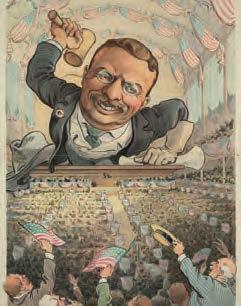
In 1912, former President Roosevelt returned to Chicago to seek the nomination of the Progressive Party, which became known as the Bull Moose Party after he announced he was “strong as a bull moose.”
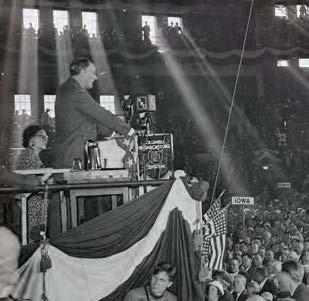
1932 Democratic National Convention: In the rst presidential election since the U.S. plunged into the Great Depression, both the Democrats and Republicans held their conventions at the Chicago Stadium, a newly constructed arena adjacent to the spot where the United Center now stands. The Democratic nominee, Franklin D. Roosevelt, went on to win the presidency and serve four terms, three of which included nominations in Chicago.
1968 Democratic National Convention: The Democrats selected Chicago to host their convention in 1968 in part because under then-Mayor Richard J. Daley the city had “avoided the urban uprisings and strikes that had plagued other U.S. cities, according to Heather Hendershot, a Northwestern University professor who wrote a book about media coverage of the 1968 convention (and no relation to this story’s author). But instead of delivering a steadying convention amid a tumultuous year, Chicago devolved into chaos as police fought with protesters in view of a national audience, an electrical workers’ strike hindered media coverage, and journalists including Mike Wallace and Dan Rather were injured in clashes with law enforcement.


The 1968 DNC stands alone among U.S. political conventions as a worst-case scenario. “It was a hit to the city, and to its reputation as a convention town,” says Hendershot. After a century as the country’s leading city for political conventions, Chicago took a nearly three-decade hiatus from hosting after the event — even as Richard Nixon, the Republican nominee and eventual winner of the 1968 presidential election, visited Chicago for a parade the week after the Democratic National Convention.
1996 Democratic National Convention: There wasn’t much drama inside the newly constructed United Center, where the Democrats re-nominated President Bill Clinton ahead of his second term. Instead, the convention gave Chicago and Mayor Richard M. Daley an opportunity to erase the stain of 1968 and put its revitalization on display — an effort that began two years prior, when the city hosted the World Cup. It worked, as a post-convention Crain’s headline proclaimed: “City,

In August, all eyes will turn to Chicago when politics will be on the plate.
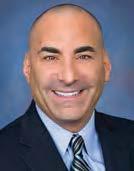
By most accounts, the Democratic National Convention will welcome 50,000 visitors with an estimated economic bene t to the city between $150 million to $200 million. Much of that will be felt by the city’s hospitality base — an industry still reeling from economic uncertainty stemming from in ation, labor shortages and the price of goods, as well as recent political headwinds that dramatically have increased the cost of doing business and decreased the chances of survival for small and minority-owned businesses. is August will provide relief and a ray of hope to a battered and bruised industry. ere could also be a long-term bene t to our city’s restaurants and bars.
Aside from politicos, state delegations and commentators, Chicago will welcome media from every corner of the country. Joining them will be representatives from many Fortune 500 companies. ese tastemakers and leaders will dine at
our restaurants, patronize our private dining rooms and host meetings in our event spaces. While they dine, drink and perhaps dance, cameras will turn their attention to our incredible dining scene to remind our country what makes this city so special. Chicago’s rst-class transportation system will help to usher them into our neighborhoods with ease, increasing exposure beyond our downtown.
In 1996, the Richard M. Daley administration foresaw the potential impact of the DNC. ere was a material e ect on the renewal of the Madison Street corridor and the West Loop neighborhood. Until the convention, we struggled to attract restaurants and visitation to this part of town. e investment in infrastructure and the attention paid to the area around and after the convention helped our city to realize the neighborhood’s very real potential.
We hope there are strategies in place to ensure this happens again.
Like every major moment and
citywide event, positive exposure matters, particularly as it inspires future investment. Despite recent challenges, there is a certain excitement among our restaurant operators, servers and chefs to welcome the world. We will play the consummate host as we always do. ere is no industry more ready.
Despite recent challenges, there is a certain excitement among our restaurant operators, servers and chefs to welcome the world.
Chicago is one of the world’s great culinary treasures because of its vibrant dining scene — one forged by 77 distinct communities and perhaps even more cultural heritages. To maintain that reputation, there must be a light that is bright enough to shine on our city. e convention, a time when politics is on the plate, is one such spotlight for our restaurants and bars.

The Democratic National Convention comes to Chicago in August, giving lawmakers and delegates from across the United States a chance to experience our beautiful home, a city that some know only from news headlines.
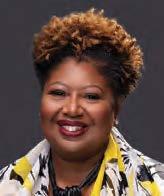
In addition to nominating a presidential candidate, they’ll dine in our world-class restaurants, see the sights and get a chance to know the people who make this town work. One of the people I hope they meet is Charlotte Austin, lead production manager at Sweet Beginnings LLC, a social-impact business established by the North Lawndale Employment Network (NLEN).
Sweet Beginnings was founded in 2004 to tackle the dire unemployment rates among Black men and women with criminal backgrounds. Recognizing that traditional employment avenues often remain closed to those returning from incarceration, this social enterprise o ers not just jobs but a bridge to a brighter future. Sweet Beginnings has hired over 750 justice-impacted individuals, providing them with job training and the chance to develop skills transferable to a wide range of industries. Charlotte oversees the production of honey and skin-care products, made with 100% raw Chi-
cagoland honey harvested from an urban apiary. Her indomitable spirit led her to the U-Turn Permitted job-readiness program, administered by NLEN.
Having the DNC in Chicago is a rare opportunity to shine a national spotlight on the work of nonpro ts like NLEN. It's an opportunity for delegates, lawmakers and national media to engage with the realities and potentials of justice-impacted individuals like Charlotte. By talking with graduates of our job-readiness programs, convention attendees can carry home stories and examples of how America can grow if we reduce the barriers to employment faced by people who have been formerly incarcerated. e MIT Sloan Management Review's study, "Unlocking the Potential of Justice-Impacted Talent," emphasizes the importance of integrating these individuals into our workforce, highlighting the mutual bene ts for society and the economy.
In 2022, 1.2 million persons were in state or federal prisons, according to the latest numbers from the U.S. Bureau of Justice Statistics. Our nation’s worker shortages would narrow dramatically if lawmakers re-examined hiring practices for people formerly involved in the criminal justice sys-

tem. So many graduates of NLEN’s award-winning U-Turn Permitted job-readiness program have become taxpaying homeowners who, in turn, donate what they can to support our program. People like them want and deserve a fair chance to rejoin society.
We are at a critical juncture where businesses, communities, and policymakers must come together to lower barriers to employment and recognize the un-
tapped potential within our midst.
Jamie Dimon, president and CEO of JPMorgan Chase, saw the untapped potential of those who have served time when he visited NLEN’s campus three years ago. He met graduates of our program and saw the work we do to support people transitioning to their new lives. ree years later, approximately 10% of JPMorgan Chase’s U.S. hires in 2023 had criminal backgrounds. Visiting DNC attendees will see
there’s nothing magical about these common-sense recommendations. ese ideas would improve the lives of every Charlotte and Jamie, no matter where they live or what type of business they run.
As we welcome the DNC to our city, let’s also welcome the opportunity to rede ne what’s possible when we invest in people and their potential to transform not only their lives, but also the communities around them.
This August, when more than 50,000 people gather here for the Democratic National Convention (DNC), the spotlight will be shining on Chicago. It will be shining even brighter than the average convention because 15,000 of those attendees will be members of the media.
Chicago is no stranger to large events. In fact, less than three weeks after the DNC, McCormick Place will host more than 100,000 people for the International Manufacturing Technology Show.
at is the equivalent of moving the entire population of a midsize city into Chicago for ve days. And we will do it awlessly — like we do every other year for one of the largest trade shows in the world.
We are honored to host the 2024 DNC and thankful to the Democratic National Committee for choosing Chicago. e massive exposure that the DNC brings will be an opportunity to show the world what Chicago does best: host major conventions, trade shows, sporting events, festivals and more, delivering incredible experiences for attendees with minimal local disruption and without incident.
ese events are critical for our economy. Last year, meetings and conventions across Chicago welcomed 2 million attendees and brought $2.6 billion in economic impact.
And after a successful DNC, our sales teams will use the publicity from the DNC to land even more events. e direct impact of previous DNCs has ranged from $150 million to $200 million, but this exposure is where the real upside lies. Not only will millions of potential travelers around the world see the best of our city and its vibrant neighborhoods, but previous DNC host cities have said the long-term impact of future events choosing their city outweighs the direct economic impact of the event.
e immediate and long-term impact of the DNC will be substantial, and we are con dent that we will deliver an outstanding event, for all of the reasons that make Chicago the best big city in the U.S. for major conventions:
We have expanded our hotel room capacity, with nearly 10,000 new rooms added over the last 10 years, allowing every delegate to stay within city limits.
We have the largest and most exible convention center in North America. e McCormick Place campus is unparalleled,


Richard Gamble is interim president and CEO of Choose Chicago. Larita Clark is CEO of the Metropolitan Pier and Exposition Authority, owner of McCormick Place, Wintrust Arena, Hyatt Regency McCormick Place and Marriott Marquis Chicago.
with 2.6 million square feet of space in four buildings, three hotels with nearly 3,000 rooms, and a vibrant sports and entertainment facility.
We have a best-in-class, skilled and diverse workforce that allows us to execute events seamlessly. Our union labor is routinely tapped by other markets because of their skills. And, across the board, Chicago is known for its collaborative, wel-
Last year, meetings and conventions across Chicago welcomed 2 million attendees and brought $2.6 billion in economic impact.
coming and accomplished hospitality community.
We thank our partners across Chicago’s tourism industry — our restaurants, theaters, venues, museums, attractions, tour operators, and more — that continuously wow visitors.
We thank our police department that knows how to execute major events. Our new chief, Larry Snelling, was a lead trainer for the NATO Summit, when the Chicago Police Department was widely praised.
And as long as protests remain peaceful, we think there is something more important that will shine on the global stage: our values.
We are welcoming of people of all races, genders and sexual orientations. We stand, this year and for many more to come, as a city and state that accepts everyone.
So if you are a company or association looking to meet in a welcoming city that knows how to produce big events, watch how Chicago puts on a spectacular DNC this summer.

A Democratic party in a Democratic city should be a moment for genuine civic pride — if everything goes well
The Democratic Party will converge on the Windy City in August to nominate its 2024 presidential candidate. Alongside 5,500 delegates visiting that week, Chicago will host approximately 70,000 other visitors, including 20,000 media members.
e stakes for Chicago could not be higher: If this once-in-ageneration event goes o smoothly, it could burnish the city’s image and remind both its residents and those across the nation everything we have to o er. I’m not talking about what goes on inside the United Center — the Democrats will have to make their own case — but instead what happens around it, which is Chicago’s chance to reintroduce itself to the nation. But crime, violence or unrest in the streets would cinch the city’s reputation as a modern symbol of urban decay. It is the di erence between the disaster of 1968 and the success of 1996. Now city leaders must make the most of the opportunity.
Most Chicagoans see value in hosting large-scale events like the Democratic National Convention, according to a recent Harris Poll survey. Seven in 10 city residents (71%) agree that attracting major non-recreational events (conferences and the like) would bene t the area. And nearly half (46%) of city residents at least somewhat support hosting political events like the convention and presidential debates, while only a small minority (5%) strongly oppose. ey have good reason to be supportive: Former Mayor Lori Lightfoot estimated that the convention will inject $150 million to $200 million into Chicago’s economy, though some question whether it will reach that number.
Such a boost could strengthen residents’ opinion of Mayor Brandon Johnson’s administration — and he needs such help. A majority of city residents (58%) say that he is not doing enough to engage the private sector in revitalization e orts. Similarly, more than half (56%) doubt that he will have a
greater impact than his predecessors on marginalized neighborhoods.
But the Democratic convention gives Johnson a rare chance to ramp up his e orts in these regards. Host cities typically invest in largescale infrastructure projects in the months leading up to the event. When Chicago last hosted the Democrats, when they nominated President Bill Clinton for a second term in 1996, then-Mayor Richard M. Daley invested tens of millions of dollars in the city, focusing on the West Loop and other still-developing West Side neighborhoods. ese projects helped shape these neighborhoods into the vibrant communities we enjoy today.
Local leadership hopes that the 2024 convention will similarly have a lasting positive impact on Chicago and its residents. As in 1996, this year’s gathering is being held at the United Center. City leaders want all of Chicago’s 77 neighborhoods to economically bene t from hosting the convention, not just the area around the United Center and McCormick Place. To involve residents from across the city, the convention leaders launched a neighborhood ambassadors program to recruit 12,000 volunteers citywide.
Improvements planned
Johnson and other leaders plan a combination of infrastructure improvements and beauti cation initiatives ahead of the convention. Proposals include updating areas around Chicago Transit Authority stations, repairing sidewalks and crosswalks, increasing security resources, and strengthening cellular and internet service in underserved communities.
Beyond physical improvements, the convention should generate signi cant business for Chicago’s restaurants, bars, hotels and other local businesses. Lightfoot, who worked to secure the convention for Chicago, promised the city would feature minority- and womenowned businesses throughout the week of the event. Tourism industry


William Johnson is CEO of e Harris Poll, a global public opinion polling, market research and strategy rm.
Non-recreational events
Do you agree or disagree with the following statement: “Attracting non-recreational events would bene t the Chicagoland area.”
29%
71%
leaders also believe that it will improve the city’s image nationwide and attract more visitors. at is key. Our city has become synonymous with crime and hopelessness. We know there is a better story to tell. Now it’s up to Mayor Johnson to ensure that every aspect of city leadership is pulling in the same direction. is should be a moment of genuine and deserved civic pride. If Johnson and other local leaders can e ectively bring wide-scale improvements to the city, we may see increased support for hosting more large-scale events in the years ahead — not to mention increased interest in coming here. It’s one of those happy moments when good economics and good politics resonate — hopefully to all our bene t.
Built in 1900 as part of a pair of neighboring properties, the home is from the early days of the master architect’s career, before he went full-on Prairie style, and is priced at $779,000 |
Ahouse in Kankakee that Frank Lloyd Wright designed early in his career, when he was on the cusp of revolutionizing the architecture of our homes, is going up for sale for the rst time since the mid1970s.
Built in 1900 as one of a pair of neighboring houses Wright designed for Warren Hickox and his sister Anna Hickox Bradley and their spouses, the house “fits into a turning point for Wright,” said John Waters, preservation programs manager at the Chicago-based Frank Lloyd Wright Buildings Conservancy.
At 33 years old, Wright was “working towards the simplicity and clarity” of the modern homes he would soon design, Waters said, but the architect hadn’t yet let go of Victorian homes’ steep pitched roofs.
Yet it’s unmistakably Wright’s work on the outside, with several broad overhanging roofs, their undersides lined with plaster and concentric banding, and many of its windows imprinted with a geometric pattern in the leading. e house, on Harrison Avenue in a neighborhood of handsome vintage homes, has been in the hands of the Brown family since 1976, when they moved to Kankakee from Evanston, 74 miles north. It hits the market March 14, priced at $779,000 and represented by Victoria Krause Schutte of @properties Christie’s International Realty.
Set on about three- fths of an acre, the house is four bedrooms in about 3,300 square feet above ground, with a big basement.
Wright designed a hexagonal line pattern for the windows and then put them in two roughly hexagonal spaces, this one on the house’s east side and a mirror image on the west, with the living room in between.
“ at pattern oats across the walls inside” as the sun moves up through the sky, said Jennifer St. Clair, who was 15 when the Browns, her parents, bought the house.
Jim Brown was working for Roper, an appliance manufacturer, and commuted to Kankakee from Evanston for a few years before getting tired of it. Fortuitously, the Wright house came on the market at about the same time, making it easy for his wife, Eve, who like him was a devotee of older homes, to commit to moving, St. Clair said. She’s not sure what her parents paid for the house.
e ample woodwork on the interior had mostly been painted white, before the Browns’ tenure, St. Clair said.
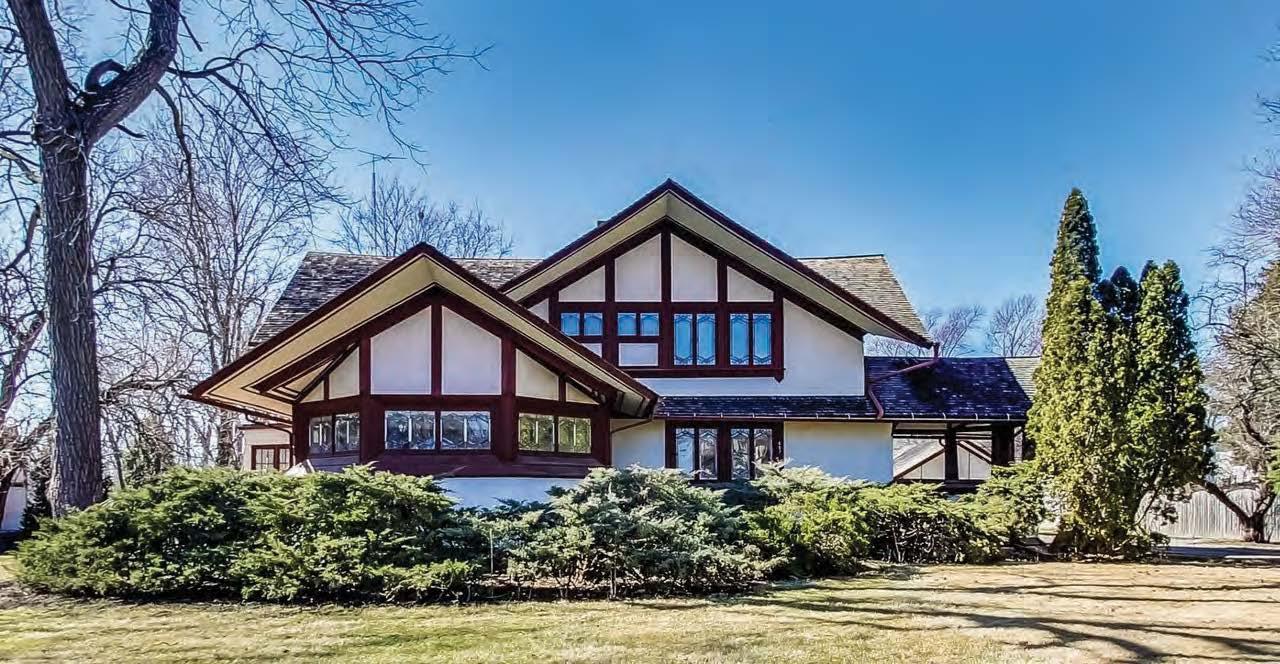

e Browns had woodwork in the living room stripped of paint to bring back the natural nish Wright started with.
A set of art glass doors that originally opened to a large terrace faces the other Wright house on the block. At some point before the Browns it was taken down and replaced with a small enclosed porch.
e listing photo doesn’t quite capture the sunny breadth and openness of this main space in the house. It’s three connected spaces: a wide living room with windows and doors along the south and the two hexagons on east and west, one seen in an earlier photo and the other, nearly identical but painted yellow.
Wright designed “an elegant space,” Waters said. “Very light” despite what would have been signi cantly more dark wood.
e tall brick replace is an element that would come to be more decorative in later Wright homes, with inglenook benches, brick arches and other artful details.
at’s not to suggest this replace is somehow lesser. With brick pillars between anking plaster walls, it’s a handsome centerpiece of the space.
e original wood oors are all intact beneath the carpeting, and in some spaces upstairs it’s
By Dennis RodkinRelated: A rare Frank Lloyd Wright home hits the market in Michigan for $790K. I PAGE 23
were few, if any, photos of the interior online in its listing.
e boxy little porch is the uninspired replacement for an original terrace that reached out from the house with the same grace as the roofs.
Rebuilding that terrace is one of several possibilities that face the next owner. Another is the kitchen, last updated sometime before the Browns bought the house.

been pulled up to reveal the rich Georgia pine.
Glimpses of the two hexagonal spaces are at opposite ends, and just to the right of the replace is a charming space Wright reportedly liked to use when he was in the house.
Wright called the inviting nook near the front door his “social o ce,” according to Paul St. Clair, the Browns’ son-in-law. With two houses underway here on Harrison Street and a growing clientele, the ambitious young architect would bring potential customers down to Kankakee to see his work and, while here, settle in the nook to confer with them.
Sitting there, he could show them his use of art glass and wood trim (it would have been natural then, not white), not to mention a long view from those benches across the living room to more windows and, beyond, another house of his design and the Kankakee River.
e turned spindles screening this nook and the staircase were also in the hexagonal rooms, at a smaller size. Wood screens show up in many later Wright homes, often with simpler shapes than these.
Although Jennifer St. Clair and her sister didn’t grow up in this house, she had a few teenaged years in it. Her bedroom faced east, with an uninterrupted view along the adjacent street.
“ e sunrise comes in through that window,” she recalled, “and at night car lights coming down the street would play o the leaded glass. It was a nice show.” It’s likely Wright anticipated the e ect of the sunrise, but not the e ect of the headlights.
e Browns’ house is at left, built in 1900 for Warren Hickox and his wife, Laura, and facing another Wright house, built the same year for Warren’s sister Anna Hickox Bradley and her husband, B. Harley Bradley.
Immediately to the right of the Bradley house is the Kankakee River, bending around the neighborhood. It’s also visible from the Hickox house looking west.
Now an arts and education center open to the public, the Bradley house has a history that includes a sordid chapter in the 1980s.
Prior to that, when the Browns moved in next door, the Bradley house was operating as a restaurant. Its patrons, St. Clair said, were among the people who would wander onto the Browns’ property, and sometimes right up onto the porch, to check out the Wright architecture.
‘Didn’t allow tours’
“My mother wanted this to be our family home,” St. Clair said. “I think that’s why she didn’t allow tours” and other public visitations to the house over the past ve decades. at’s why there
A new kitchen could be larger than this, incorporating some of the neighboring spaces, such as the breakfast room seen beyond the doorway.
Because those spaces are available and don’t really speak of Wright anymore, Waters said, “you can put in a new kitchen without undermining the architectural integrity of the house.”
Utilities are all in working order, according to the home’s listing agent, although they’re decades old. While she, the sellers and Waters all say the house is entirely livable as is, it’s most likely a buyer will opt to have some or all of the work done to bring the house fully into the 21st century.
Also ready for new ideas: the basement, complete with antique formica oor next to a 1950s-esque bar. An advantage down here is that the basement was built at full height, unlike some vintage homes. Digging out the oor isn’t needed. is house and the one next door went up 124 years ago, during what Waters says was “a fertile year for Wright.”
Wright had left Louis Sullivan’s architecture o ce seven years earlier to set up his own shop and had designed some artful homes, including the Winslow house in River Forest and the Heller house in Hyde Park.
As the 19th century dissolved into 1900, Waters says, “Wright was busy.” He designed the Kankakee pair, a house in West Pullman with roof lines that look like an early draft of those on this house, and a house in Beverly.
All of those, Waters suggests, helped Wright get to the next step, “his rst mature Prairie design,” the Ward Willits house built in Highland Park in 1902.
If so, that makes the house he designed for the Hickox family, which has been stewarded for half a century by the Brown family, an important bridge for what was to come from Wright.
The station is in the middle of its spring pledge drive and says the focus on digital platforms is necessary for it to ourish
no access to the internet.
WBEZ rolled out a new lineup of midday programs on March 4, days after announcing it would cut its two-hour local news talk show, “Reset with Sasha-Ann Simons,” to one hour. e change would allow the National Public Radio a liate to focus on its digital audience, it said. But the new lineup does not have the local focus that “Reset” brings. It includes two one-hour nationally syndicated NPR programs: news magazine “Here & Now” and “Fresh Air,” co-hosted by Terry Gross and Tonya Mosley. In trimming “Reset,” the station seems less focused on local programming, but Tracy Brown, chief content o cer for Chicago Public Media, says that’s not the case.
“We’re creating content for a younger and more diverse audience,” Brown said. “ ose people aren’t able to listen at that time of the day, either because they are at work or for other reasons. e majority of the people who have the capacity or the time to listen at that time of day are traditionally going to be your older listeners.”
WBEZ plans to use social media platforms Instagram and YouTube more and expand its reach through the morning “Reset” newsletter, which includes links to the show’s podcast, and the afternoon “ e Rundown” newsletter, which features links to Chicago Sun-Times and other news sources’ stories.
Larry Stuelpnagel, associate professor at Northwestern University’s Medill School of Journalism, Media, Integrated Marketing Communications, said while he understands WBEZ’s focus on digital, he worries about the impacts on audiences that may reside in “digital deserts,” where there’s limited or
“WBEZ, and public media in general, does a much better job of reporting about underserved communities than commercial operations do. And so, the question then becomes, what about these underserved communities?” said Stuelpnagel. “It has the potential to not be a good thing for serving those communities (where) they have traditionally even set up bureaus. . . .What’s going to happen to those? What’s going to happen to that reporting? So, there is concern there.”
According to its most recent annual report, the station’s audience is 48% white, 23% Hispanic and 18% Black.
Impact of broadcast cuts
Stuelpnagel cautions WBEZ on the possible impacts the broadcast cuts may have on audiences speci cally on the South and West sides of the city. Data from the University of Chicago Data Science Institute shows that households on the South and West sides are the most disconnected from the internet. Up to 40% of households lack internet in the least connected communities. WBEZ didn’t make any layo s with the “Reset” cuts. e station saw its programming expenses drop roughly $46,000 in scal year 2023 from the year before, tax forms show. While it costs more to run a locally programmed show versus a syndicated program, the station isn’t saving money from its decision to cut “Reset,” Brown said. Funds are being reallocated toward digital e orts.
WBEZ, which is a nonpro t, launched its annual weeklong spring pledge drive on March 7. e station receives the majority of its revenue from grants and individual support, or memberships. It’s not clear what the

spring pledge drive’s fundraising goal is, but in past drives, goals have been several hundred thousand dollars. As of the morning of March 12, the station said it still had around $360,000 left to raise.
Pledges from the station’s members account for approximately two-thirds of its budget.
WBEZ said public support allows it to “focus on delivering more news.” It’s not clear what percentage of its fundraising comes from younger listeners.
e drift from local broadcast programming contrasts with the goal of former Chicago Public Media CEO Torey Malatia, who dreamt of all-day local programming and was heralded as a trailblazer for changing the station’s format and introducing Chicago’s urban alternative station Vocalo 91.1 FM.
But as the local media landscape shifts, WBEZ’s focus on its digital platforms is what is necessary for it to ourish, according to Brown.
“Just like print on the newspaper side, the audience for print is dwindling while it’s growing on digital. If we are going to be responsible stewards of the future
and really trying to maximize our audience opportunities, particularly to grow younger and more diverse, we have to play more in that digital space,” Brown said.
e Chicago Sun-Times, which was acquired by Chicago Public Media in 2022, dropped its digital paywall that same year in an e ort to increase readership. Chicago Public Media CEO Matt Moog told Nieman Lab that readership is up by roughly 500,000 people a week compared to last year, though delivery subscriptions dropped about 6% each year.
As a multiplatform news organization, Chicago Public Media’s goal is to serve its broadcast audience and be responsive to listener habits, Brown said.
e station recently did a reader survey to address topics its audience wants to see more of, she said, adding that the Sun-Times allows the organization to have more local reporting on the digital side. Survey results are for internal use only, said Lucy Kim, chief advancement o cer at Chicago Public Media.
Eyes are still on the organiza-
tion after its unprecedented acquisition of the Sun-Times, which maintains a separate newsroom from WBEZ. Chicago Public Media is actively looking for a new CEO to replace Moog, who announced in December that he’d be stepping down to return to his tech industry roots. Two other executives left their positions following Moog’s announcement.
“I hope it works out for them,” Stuelpnagel said of the move to cut local broadcast programming. “I am wondering why they had to cut the local programming down and not take that extra hour of their local programming (to) re-harvest that in-depth as they say they’re going to do on the digital side. I consider them, and NPR in general, one of the most vital and accurate sources of information in the media landscape in America and Chicago.”
In its most recent tax ling for scal year 2023, which ended in June, Chicago Public Media reported $38.7 million in total revenue compared to $32 million for 2022.
The Chicago-based accounting company joins a trend of professional services providers taking such investmentsBrandon Dupré
Professional services giant
Grant ornton has opened the door to private equity, joining a recent trend of professional services rms making the move.
Investment group New Mountain Capital, which manages about $50 billion in assets, has purchased a stake in the Chicago-based accounting rm. While terms of the deal were not disclosed, the two companies in a
press release referred to it as a “signi cant growth investment.” e Financial Times reported the deal was for a majority stake in Grant ornton. e rm's representatives declined to comment on the size of the deal.
It’s the latest example of private equity’s push into the professional services sector, attracted by accountancy's steady returns and the upside of higher margins on the faster-growing consulting side. e deal also
marks one of the service industry’s largest rms turning to private equity.
“ e investment immediately enhances our value in the marketplace and enables us to accelerate our current strategy,”
Seth Siegel, CEO of Grant ornton, said in the press release.
“We’ll enjoy greater scale, resources and agility, while better positioning the rm to make targeted investments in talent, technology, infrastructure and
enhanced capabilities.”
Last year, Grant ornton laid o around 300 U.S. employees, or about 3% of its workforce in the country, despite recording record revenue for its scal year ending July 31, 2023. It announced revenue of $2.4 billion for that year, up from $2.3 billion the previous year, signaling that the expected industry freeze from a frenzied post-COVID surge may not have arrived.
In the press release announc-
ing the deal, Andre Moura, managing director at New Mountain Capital, said “we look forward to working with Grant ornton to invest further in technology and automation, talent and new service line capabilities to achieve rapid growth — while maintaining an unwavering focus on quality and client experience.”
Grant ornton ranks No. 9 on Crain's most recent list of the Chicago area's largest accounting rms.
It took just one day for the Chicago-based agricultural commodities trader to lose the amount following news of a probe into its accounting practices. Bouncing back will take a lot longer, as its strategy to diversify has faltered.
Gerson Freitas Jr., Isis Almeida and Anne Riley Moffat, BloombergIt took just one day for Archer Daniels Midland Co. to lose more than $8 billion in value following news of an investigation into its accounting practices earlier this year. Bouncing back will take a lot longer.
e storied agricultural commodities trader, which historically dubbed itself the “supermarket to the world,” has spent billions to grow its nutrition unit, the business that makes pet food and veggie burgers that’s now under scrutiny. But the strategy to diversify beyond corn, wheat and soybean trading — ADM’s staples — has faltered, with no obvious alternative in place.
To make matters worse, the cycle for its core agricultural commodities has turned, with rising grain inventories sparking predictions of more price declines ahead. While ADM said on Tuesday it’s taking aggressive steps to x its nutrition business — slashing product lines and mulling potential asset sales — investors may not be rushing to re-buy shares any time soon. ADM has only regained a fraction of its diminished market capitalization in the nearly two months since it disclosed the probe.
“ADM is going to have to show that the nutrition business can grow,” said Seth Goldstein, an analyst at Morningstar Inc. “ ey need to show pro t growth and margin restoration back closer to what we saw in 2021, 2022.”
Chicago-based ADM has helped put the “big” in Big Food for more than a century. Grab a slice of bread in the US, a tortilla in Mexico or a pork dumpling in China, and the odds are good that the company or rivals Bunge Global SA, Cargill Inc., or Louis
Dreyfus Co. — known as the ABCDs of crop trading — had a hand in it.
But as pro ts for their traditional businesses started to slump about a decade ago, the trading houses pivoted. Cargill focused on growing in beef, Bunge sold under-performing assets and Dreyfus shrank and tried to move downstream.
ADM’s growth strategy centered around human and animal nutrition. It spent $3 billion to acquire Wild Flavors GmbH and another $1.8 billion to take over animal-feed maker Neovia, the company’s largest-ever deals. But that bet has largely failed to live up to expectations, due in part to faltering demand for plant-based ingredients and animal feed.
For a while, Russia’s invasion of Ukraine, which sent grain prices soaring, boosted overall earnings, diverting attention away from nutrition. But an internal inquiry into accounting practices in the nutrition segment, sparked by a document request from the top US securities regulator, threw the unit into the spotlight again. A federal investigation has followed, with the company con rming on Tuesday that some of its employees had received subpoenas.
“Nutrition has been a growth story for many years, and we certainly stumbled in 2023,” Chief Executive O cer Juan Luciano said a call with analysts, citing a mix of market forces and company missteps.
Probes by the U.S. Securities and Exchange Commission and the Department of Justice center around transactions between the nutrition business and other segments. After ADM’s own internal investigation, the company has reinstated some intersegment results for the past several years.

Operating pro t in the nutrition unit was reduced by 7% on average between 2018 and 2022, Morgan Stanley analysts said, “which we think is likely to be viewed as better-than-feared all else equal.” e company also announced more share buybacks, which helped boost the stock by as much as 6.5% during intraday trading.
But returning to stock-price levels seen earlier this year will take a while. A number of investors won’t even be able to buy the shares before the investigation is fully concluded, said Sam Margolin, a managing director at Wolfe Research LLC.
“Some investors have written into their proxies or their bylaws that they might be restricted from buying stock while the company is under investigation,” he said. “But also during the investigation
the company is not able to answer every question about the business directly. As long as that’s the case, there’s going to be a certain amount of investors who can’t buy the stock.”
ADM’s nutrition unit reported operating pro t that tumbled 36% last year, far worse than the single-digit declines in its other key businesses. e segment also recorded a rare operating loss during the fourth quarter.
Luciano is now promising a turnaround for the beleaguered unit. He has cut the number of brands it o ers customers by two-thirds and slashed individual product o erings by 17%, reducing production-line complexity. e company has also replaced the unit’s management team and ended its 50% jointventure in ADM Vland Biotech Shandong Co. Ltd., which makes
human probiotics in China. ADM said it has hired third-party experts to nd more ways to improve the unit.
e nutrition division still has an important role in ADM’s business model, Luciano said. Still, the company constantly reviews its underperforming assets and has in the past opted to divest when it made sense, from its Bolivian oilseeds operations to its global cocoa business.
“We make sure that if there are some things that are selfin icted, we correct those things,” Luciano said. After that, ADM decides “whether they belong in nutrition, or they belong in another part of ADM, or they belong outside ADM.”
“We’re in that process,” he added. “Nothing to announce today, but we continue to look at that very deeply.”
The deal for the upcoming 2024 season makes the brewer the Chicago Sky’s rst of cial craft beer sponsorJack Grieve
Revolution Brewing is partnering with the Chicago Sky to become the WNBA team’s rst ocial craft beer sponsor for the upcoming 2024 season.
Revolution, the self-proclaimed largest independently owned brewery in Illinois, will o er fans at Wintrust Arena its Hero IPA series — including the popular Anti-Hero IPA — as well as its new lager, Cold Time.
Revolution is already available at Wintrust Arena, the Sky’s home stadium, but the brewery promises
to “become a noticeable presence on gameday” as the team’s o cial sponsor, according to a press release announcing the partnership. at increased presence will include a branded “Hero Deck” seating section at Wintrust and ingame scoreboard races featuring the brewery’s mascot characters. e Sky partnership is Revolution’s rst in women’s sports. e brand recently announced a new partnership with the Chicago Hounds, the rugby club that plays in Bridgeview, and resigned its deal with the Chicago Fire FC for a third year.
Revolution’s partnership with the Sky comes as the state’s craft beer industry continues to struggle. Ten percent of the state’s breweries have closed in the past two years as taproom tra c failed to return to pre-pandemic levels. Craft beer distribution has also decreased as consumer drinking habits have changed.
e Sky’s home opener at Wintrust is set for May 25 against the Connecticut Sun.
“We envision further champions and ever-more-broken doors in the visiting locker room,” the brewery posted on X on March 13.
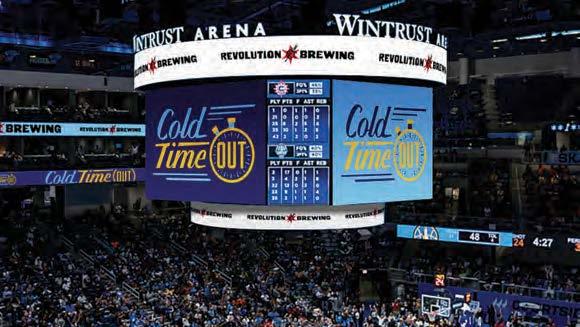
1540 N. Roselle Rd., Schaumburg, IL 60195 847-519-7555 • bellawood red.com
Bella Napoli takes inspiration from the kitchens of Naples, crafting the best wood red Neapolitan pizzas in the Chicago suburbs along with many other unique chefs’ creations, paired with an innovative cocktailing experience and entertainment. Be the rst to nd a seat at the most gorgeous marble-topped bar in the Northwest area, overlooking the patio, open kitchen and deluxe wood red oven.
Bucktown: 1840 W. North Ave., Chicago, IL 60622 312-847-4614 • ettarestaurant.com
Elevate your private dining experience at etta. The restaurant’s relaxed ambiance creates a professional yet inviting atmosphere, complemented by a diverse menu of wood- red entrees, artisanal pizzas, handmade pasta and farm-fresh salads. Our team of attentive staff will ensure that every detail is taken care of, allowing you to enjoy your meeting, party or gathering.


West Loop: 494 N. Milwaukee, Chicago, IL 60654 Lakeview: 3025 N. Clark St., Chicago, IL 60657
Gold Coast: 2 W. Elm St., Chicago, IL 60610 312-414-0955 • dolciamori.com
Dolci Amori, Chicago’s authentic Italian pastry shop founded by Napoli native Ciro Longobardo, blends traditional “Italian Pasticciera” and “Rosticciera.” Our top priority is always freshness and quality. Explore unique contemporary Italian pastries, pizzas and paninis crafted by our renowned team from Italy, led by a 40-year experienced Pastry Chef.
120 W. Monroe St., Chicago, IL, 60603 312-312-2142 • llmorerestaurant.com
Discover the ideal spot for your next business lunch in the nancial heart district: The Fillmore Italian Trattoria & Bar. Its inviting ambiance and delectable cuisine offer the perfect setting to impress clients or catch up with colleagues. Indulge in authentic Italian avors and elevate your lunch meetings at The Fillmore.





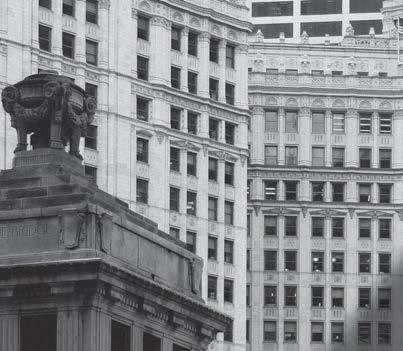


From Page 1
e pension fund ultimately passed, sending the developer back to the market for a new capital partner to nance Lincoln Yards after its two primary backers — New York-based J.P. Morgan Asset Management and Dallas-based Lone Star Funds — sought to sell their stakes in the project at substantial discounts, signals of their waning patience with the development’s path forward.
Sterling Bay and Kayne Anderson executives met with city planning o cials on Feb. 26 to discuss the Lincoln Yards project, a spokesman for the city’s Department of Planning & Development con rmed.



Sources familiar with the meeting said Kayne Anderson was gathering information about Sterling Bay’s approved planned development and the nature of the redevelopment agreement the developer struck with the city, which includes details of a tax-increment nancing district meant to help back construction of new infrastructure on the site. Kayne Anderson and Sterling Bay did not indicate a partnership or new development was imminent or propose any changes to the plan, sources said.
District and on the city’s Near West Side. Sloniger, who did not respond to a request for comment, is said to be serving in an advisory role to Kayne Anderson.
Kayne Anderson has bet heavily on Chicago real estate in recent years, particularly in the medical o ce sector, where it owns dozens of properties in partnership with Chicago-based Remedy Medical Properties. e real estate rm — whose parent company, Kayne Anderson Capital Advisors, is based in Los Angeles — has more than $14 billion in assets under management across a mix of property types, according to its website.
Pitch to investors
As proposed, Lincoln Yards would include a mix of o ces, residential units, retail and other uses, as well as towers rising as high as 595 feet. Sterling Bay estimated in 2019 that the project would generate 24,000 permanent jobs and serve as a massive tax boon to a city battling nancial woes.
several Chicago projects — to “participate” in a plan to bring Lincoln Yards under a single ownership entity rather than the previous split between Lone Star and J.P. Morgan Asset Management.
Sterling Bay appears to have bought itself time so far. Cook County property records show the developer and Bank OZK in November modi ed terms of the loan to change the maturity date, though the new deadline to pay o the mortgage was not disclosed. A Bank OZK spokeswoman did not respond to a request for comment.
Since winning City Council approval for Lincoln Yards in the waning days of Mayor Rahm Emanuel’s term in 2019, Sterling Bay has developed only a vacant life sciences lab building on the site at 1229 W. Concord Place. e developer has been vying to begin major infrastructure work needed to kick-start other developments.



“ e recent meeting involved a basic discussion of zoning entitlements and (redevelopment agreement) obligations for Lincoln Yards,” a planning department spokesman said in a statement.

e developer’s recent pitch to prospective investors for Lincoln Yards has framed the project as a compelling opportunity to buy in at a remarkably low value and therefore get a higher return if the developer can bring its vision to life. Manulife Global Head of Real Estate Marc Feliciano, whose rm is a development partner with Sterling Bay on the project, told the Chicago Teachers’ Pension Fund’s investment committee last year that the price of entry was “as good as it gets from a historical perspective. . . .Nothing’s ever guaranteed, but I’ll go as far as saying it’s hard to lose money at this basis.”
Sterling Bay CEO Andy Gloor publicly blamed former Mayor Lori Lightfoot’s administration for holding up nancing that would have allowed the developer to begin such infrastructure work. e developer pitched Lightfoot and senior advisers in 2022 on a bond deal that would have raised hundreds of millions of dollars through the Wisconsin-based Public Finance Authority to help nance things like new roads and bridges, a proposal that needed city approval because the transaction would involve the issuance of city notes backed by tax-increment nancing proceeds.


A Sterling Bay spokeswoman did not respond to a request for comment. A spokesman for Kayne Anderson declined to comment. Industry publication e Real Deal Chicago, which rst reported news of the meeting, cited a statement from Kayne Anderson noting that the rm would provide more information “on this process as there are updates to share.”
Lightfoot eventually approved the deal, but only after rising interest rates soured the economics of the proposed nancing, according to Sterling Bay, which told Bloomberg last year that Lightfoot “put a brake on our entire project.”






Among those involved in the meeting was Darren Sloniger, who stepped down last year as CEO of Naperville-based developer Marquette. Marquette has developed apartment projects over the past several years in the Fulton Market
But the nancial storm at Lincoln Yards goes beyond its nancial backers walking away. Complicating matters is that Little Rock, Ark.-based Bank OZK has a $126 million loan tied to a large chunk of Lincoln Yards’ northern portion that was slated to mature last summer, according to a presentation to Sterling Bay investors obtained by Crain’s. Sterling Bay told investors in that presentation that there were “no further extensions available” for the loan and that the developer was hoping to get Bank OZK — which has partnered on
Lightfoot last summer red back, calling the developer’s comments “unfortunate and demonstrably false,” stating that Sterling Bay didn’t bring the city into the bond sale discussion until after it had been fully negotiated with the PFA, forcing city ocials to sift through hundreds of pages of documents to ensure Chicago taxpayers would not be put at additional risk.

The Daily Gist is a premier podcast from Crain’s Chicago Business presenting a 15-minute look at the top daily stories – selected by Crain’s editorial team – featuring WG N radio host Amy Guth and interviews with Crain’s reporters, editors and power players in Chicago business.
Monthly industry-exclusive sponsorships, including a live-read on air Monday through Thursday, available now!
Full and partial year sponsorships available.
E-mail Christine Rozmanich at crozmanich@crain.com or scan the QR code to fill out our form.

From Page 3
early in the COVID-19 pandemic when the pit shut down and customers found it harder to get large orders filled discreetly in the electronic marketplace as any moves they made were quickly mirrored by online competitors.
“During the first few months when COVID hit and everything went electronic in March, April and May of 2020, a lot of customers complained . . . that they had to pay six or seven different prices to get the same contracts done,” he said.
Post-pandemic, Cboe moved and improved its trading floor when the company relocated its headquarters within downtown Chicago. The new floor, which opened in 2022, is located at the Chicago Board of Trade building at 141 W. Jackson Blvd. Since that opening, the population on the floor has increased to around 300 as trading firms boost the number of floor brokers and market makers working there to
From Page 3
untapped potential — a new beverage space, if you will.”
e potential reward comes with risks. e often-e ervescent drinks are not part of the state’s recreational marijuana economy because the THC added into them does not come from weed. It is extracted from hemp, which is less regulated in Illinois than its more potent cousin.

capture the rising volume.
“It has just grown in adoption.
e S&P 500 really has been the go-to barometer of the U.S. equi-
duced last year, but its provisions are being negotiated. In other words: e products are legal because they are not illegal. Craft breweries around the state are deciding that the potential of a new revenue stream is worth the risk of operating in an unregulated market.
“ e lack of regulation and guidance doesn’t create express authority to make this beverage,” said Ray Stout, executive director of the Illinois Craft Brewers Guild. “But it does create an at-
Many consumers are switching away from craft beer, turning to wine, spirits and ready-to-drink canned cocktails, or drinking less altogether and opting for nonalcoholic options.
A 2018 federal law made it legal to farm hemp around the country and sell it between states, a luxury that the marijuana industry does not share. Under that law, hemp is legal if the plant’s THC content is less than 0.3% when it is dry. Processors can create potent THC distillate by extracting from a larger volume of hemp plants.
e legality of infusing that THC into beverages and selling them in a taproom or liquor store are, admittedly, murky. ere is no law in Illinois regulating or taxing the sale of hemp-derived THC products. One was intro-
From Page 3
priced similarly.
“People are willing to spend a little more money living in a slightly larger unit in the suburbs,” Taylor said. “But $2,000 is a crazy number, and it’s probably here to stay.”
Suburban rents were up 5.4% year over year in the fourth quar-
mosphere where people who are looking for alternative income streams may feel the reward would outweigh any potential enforcement action.”
Hopewell Brewing in the Logan Square neighborhood is one of them. e eight-year-old brewery recently launched a THC-infused sparkling beverage that it calls Choom. e 8-ounce cans have 10 milligrams of THC. Hopewell also sells Choom Lite, with 3 milligrams of THC in the same size of can. Both drinks are nonalcoholic, have real juice and just a few calories. e drinks are sold at liquor stores and in Hopewell’s taproom.
ter of 2023, according to Integra, outpacing slower rent growth in downtown Chicago.
Integra’s analysis attributed the heightened demand for apartments outside the city in part to increased work-from-home exibility making living farther from employment centers more attractive. Taylor, who founded Compasspoint Development after
ties market.” Clay said. “We have always recognized that the oor environment is really what sets us apart in terms of such great liquid-
Co-founder Samantha Lee said the brewery has taken measures to mitigate the risks of operating in an unregulated market. It put a QR code on the Choom cans that links to a hemp analysis, and trained its employees on how to spot customers that have had too much. It also worked with brewers who sell hemp-derived THC beverages in Minnesota, where such products are more regulated. “We haven’t launched something like this before. For us, it’s worth it to risk this question mark we have around the regulation in order to be part of that initial excitement,” Lee said. “It’s another way to be welcoming to folks who may not be drinking as much.”
Consumer behavior has changed in the four years since the pandemic hit. Taproom sales — where the industry made 70% of its revenue pre-pandemic — did not fully recover. Craft beer sales from distributors to retailers such as liquor stores and restaurants also decreased.
Many consumers are switching away from craft beer, turning to wine, spirits and ready-to-drink canned cocktails, or drinking less altogether and opting for nonalcoholic options. Even with in ation factored in, nationwide instore sales of craft beer are down 8.3% from two years ago, according to data from market research rm NIQ. In contrast, spirit-based ready-to-drink cocktail sales are up 49.9% during the same period.
stints at Minneapolis-based developer Opus Group and Chicagobased apartment owner Equity Residential, said his apartment projects also provide a convenient location for people who work in the suburbs while also being close to the communities’ transit stops and downtown amenities.
“We’re just capturing demand for o ce tenants while giving people a shorter commute,” he said.
Each of the projects in Compass-
Russell 2000 Index and SPDR S&P 500 ETF Trust options, but volumes are much smaller.
At Cboe’s larger rival, CME Group, open outcry trading has been reduced to just one pit, where about 75 traders handle around 1.5 million contracts of Secured Overnight Financing Rate (SOFR) options each day. CME’s pit also is located at 141 W. Jackson.
Both trading floors sit just a few stories above what will become a Chicago Board of Trade museum commemorating the storied days of open outcry trading.
But the demise of the pits has been exaggerated, said Paul Aronson, who trades S&P 500 options at Cboe for Optiver.
ity and great price discovery.”
Cboe’s 10 trading pits on the seventh floor also offer open outcry trading in products including
Nonalcoholic beer sales are up 25.8%.
Worsening matters is the massive debt load many breweries carry, taken on to survive the pandemic’s darkest days. Others expanded just before the pandemic hit and must grow to reach that increased capacity.
e almost 10-year-old Noon Whistle tripled the size of its Lombard brewery in 2019 and opened a second location in Naperville. at was about twothirds complete when the pandemic hit in 2020.
With two locations and more brewing capacity, Noon Whistle’s revenue is growing, but it’s “just not what we expected,” Condon said. e brewery has been launching new products to help boost growth, including hard seltzer and nonalcoholic sparkling hop water. Noon Whistle launched a CBD-infused sparkling water called Pause about a year ago and last month rolled out Pause+, it’s hemp-derived THC-infused water.
Three avors
e drinks have 2.5 milligrams of THC in a 12-ounce can. ey come in three avors: Wildberry, Tropicool and Lemon-Lime Lift.
“People are looking for more options,” Condon said. ough craft brewers see big potential in the drinks, many remain prudent with their launches. It’s a way to mitigate the risk of
point’s pipeline will total about $40 million to $50 million in development costs, Taylor said. e developer is still working on securingnancing for the rst project in the pipeline — something that’s been a challenge for the real estate industry since interest rates hit record highs in 2023.
Compasspoint’s completed project in Des Plaines was nanced with carpenters union money after the developer lost the original -
“In 2001, I was the new guy, and people were telling me I was going to need to find a new job because the floor would be closed soon,” Aronson said. “It has been a kind of continuous theme throughout my career that the floor is going away, and it never has. All I’ve known is for it to maintain relevance and add value to the marketplace.”
operating in an unregulated market: Keep the revenue share of these beverages low, in case regulation wipes it out.
At Church Street Brewing Company in Itasca, owner Lisa Gregor is hoping its new THC-infused drinks will be “one of the things that kickstarts” growth. e brewery is working on getting its distillers license and opened a small restaurant to help diversify revenue streams. Gregor expects the THC-infused beverages to account for 5% to 10% of revenue.
“We’re just testing the waters right now,” she said. “We don’t want to go too fast.”
State Rep. La Shawn Ford, D-Chicago, introduced a bill last year that would regulate hempderived THC products using Illinois’ recreational cannabis law as a model. Sellers and producers of such products would need to be licensed, and the products would be taxed. ere has been pushback, including from established cannabis companies. e bill, which sits in the rules committee, is being debated, Ford said.
Meanwhile, the unregulated industry continues to grow, said Bryna Dahlin, partner and chair of the cannabis industry group at law rm Benesch.
“ is most likely already is a huge industry, and it’s only going to get bigger,” she said. “It’s going to be di cult to put the genie back in the bottle.”
nancing amid the COVID-19 pandemic in 2020. Taylor said the rm is exploring conventional nancing options as well as going back to the unions, which are motivated to keep their members working.
“I’ve never not been able tonance a deal in pretty much any market, and the fact that I was able to do so during the pandemic shows that there’s an appetite still in the toughest of times to nance projects,” Taylor said.
It is one of four Usonian-style houses in Kalamazoo designed by the architect, and includes original furnishings and blueprints
Rachel Watson, Crain’s Grand Rapids BusinessOne of the four Frank Lloyd Wright-designed homes in Kalamazoo is on the market in a deal that includes original furnishings and blueprints.
Seller David Gunther Wood, of Texas, listed his home in the Parkwyn Village community of Kalamazoo’s Winchell neighborhood on March 6 for $790,000.
Realtors Fred Taber, of Jaqua Realtors in Portage, and Victoria Krause Schutte, of @properties Christie’s International Real Estate in Oak Park, Ill., have the listing.
e four-bedroom, two-bathroom dwelling was completed in 1951 and is called the McCartney House after the original owners, Ward and Helen McCartney, who hired Wright to design it.
It comprises 1,671 square feet on an approximately 1-acre wooded lot. e house itself has an unusual shape consisting of intersecting triangles, a layout Wright referred to as “experimental” when presenting the plans to the McCartneys, according to writings by Helen McCartney published by the Frank Lloyd Wright Foundation.
Wood, who previously owned and restored another Wright home, said he and his partner are selling it because they were not able to devote as much attention to upkeep as the property deserves.
produce attractive, low-cost homes that most middle-class Americans could a ord.
e resulting designs, only 60 of which were ever built, featured single-story structures with lowpeaked or at roofs, cantilevered carports, built-in shelves and cabinetry, tall windows to let in sunlight, radiant heat embedded in the oors, and a central hearth.
A group of idealistic Upjohn scientists pitched a plan to Wright in 1946-47 to design a cooperative community of Usonian homes with jointly owned amenities and infrastructure. e group ultimately splintered into two factions — families who wanted to live in Galesburg and those who preferred Kalamazoo. Each group bought acreage, and Wright helped develop the plan for the neighborhoods. He was in his 80s at the time.
Although Wright designed eight homes, many elements of the subdivisions never came to fruition. In Galesburg, a fth home was added by Wright’s student Francis Willsey, and in Kalamazoo, other homes by di erent designers sprang up to complete the neighborhood.
Taber, one of the real estate agents for this listing, said there are two schools of thought for pricing Usonian homes. Some people feel the list prices should factor in the historical value and connection to a famous architect like Wright, while others think that
The four-bedroom, two-bathroom dwelling was completed in 1951 and is called the McCartney House after the original owners.
“By not being there more than a week or two a year, it’s not fair to the house,” he said. “Being the owner of a Frank Lloyd Wright house, or any signi cant architecturally designed house, there is constant work that needs to be done to keep the driveways clean, the sidewalks clean, leaves o the roof … because you want the house to always look pristine. You never want defects in the house to develop over time because you’re not going to be there for another nine months.”
History of the property
e home is one of eight Wrightdesigned, Usonian-style houses in Kalamazoo County — four in Galesburg in e Acres community and four in Kalamazoo’s Parkwyn Village.
Usonia is a moniker derived from the phrase “United States of North America” and was Wright’s preferred term for America, according to a book of re ections he published later in life. Usonian homes were Wright’s attempt to


through it.”
e brokers said although they’ve hosted some showings — including for a docent at the Wright-designed Meyer May House in Grand Rapids — they have not yet received any written o ers on the McCartney House.
Property records show Helen McCartney, who died in 2008, lived in the home for 54 years until 2005, and it has had ve subsequent owners.
the homes should be kept a ordable for middle-class buyers in perpetuity.
“ eir mentality is that, ‘Oh, those homes were never meant to be expensive,’ and it’s just odd to see that mindset,” given in ation and the historical value of the properties, Taber said.
He and Krause Schutte said they tried to strike a balance, basing the list price for the property on its relative size compared to other Usonian homes, as well as acreage, setting and condition.
e other two Wright homes on the market in Galesburg, the Eppstein and Pratt homes that are part of e Acres, are priced at $4.5 million for the pair because they are larger with more acreage, Taber said.
“ is (McCartney) home is smaller and has not been restored to the level that the Eppstein and Pratt have, either. Plus, the location is di erent,” Taber said.
Added Krause Schutte: “ e Acres is more rural, and there just aren’t as many people going
e Meyers family who acquired it in 2012 began the restoration process using the home’s original blueprints, and the next owner, Timothy Nakasawa, continued the work.
Wood and his partner bought the house in November 2021 for $425,000. ey then invested thousands of dollars into additional restoration projects, including repairing and re-staining the exterior concrete blocks; restoring a 20foot section of the exterior screens, windows and doors to match the original blueprints; and installing a new hot water boiler system for the furnace and radiant heating.
ey also added a security system that will be included in the sale.
“ e new owner will just need to get a subscription with the local security monitoring company, but the hardware itself stays,” Wood said.
Wood also built triangle-shaped furniture for the home that matches designs provided in the original blueprints.
e blueprints, along with all of the original built-ins, a pair of watercolor paintings by Helen McCartney, the beds, sheets and towels, and the furniture Wood built, are included in the listing.
ChicagoBusiness.com
President and
Editor Ann Dwyer
Managing editor
Creative director
Director of
Assistant managing editor/special projects Ann R. Weiler
Assistant managing editor/news features
Cassandra West
Deputy digital editor
Associate creative director
Art directors
Copy editors
Todd J. Behme, Beth Jachman, Tanya Meyer Political columnist Greg Hinz
Notables coordinator
Newsroom (312) 649-5200 or
SENIOR REPORTERS
Ally Marotti, John Pletz, Dennis Rodkin REPORTERS
Katherine Davis, Brandon Dupré, Danny Ecker, Leigh Giangreco, Jack Grieve, Rachel Herzog, Corli Jay, Justin Laurence, Steven R. Strahler, Mark Weinraub
Researcher Sophie H.Rodgers
ADVERTISING
Senior vice president of sales Susan Jacobs (312) 649-5492 or susan.jacobs@crain.com
Sales director Christine Rozmanich (312) 649-5446 or crozmanich@crain.com
Events specialist Kaari Kafer
Account executives
“ e original (triangle tables anking the concrete wall) in the dining room, they are the originals to the house. Some of the other ones that are the smaller tables, like the end tables, co ee tables for the sofa and freestanding table in the dining room, those I built and brought up there from Texas,” Wood said. “I learned a lot, followed the blueprints and cut them to the exact dimensions and angles that were in the blueprint.”
During his ownership, Wood said he grew to appreciate the neighborhood surrounding the home.
“ e biggest advantage is the neighbors,” he said. “ ey’re all very friendly, very easy to work with. I’m not the most social person in the world, and so it’s nice to be able to be in Michigan and talk with the neighbors, walk the dog together — stu like that.”
Last October, he was asked to host a local Boy Scout troop fundraiser, which was the only time he opened the home to the public.
“I worked with a docent, and the docent and I gave everyone tours of the house and gave them a little bit (of) the history,” he said.
Wood said he also appreciated the home’s private setting tucked away in a far corner of the subdivision, with the entire backside of the home facing the Asylum Lake Preserve. Because there are so many windows, it’s easy to see wildlife and feel part of nature, he said.
“It’s a very pristine area to live in, either full time or part time,” he said. “It gives you the convenience of being close to the city and the services, but it also gives you the seclusion.”
Linda Gamber, Claudia Hippel, Menia Pappas, Bridget Sevcik, Laura Warren
Sales administration manager Brittany Brown
People on the Move manager Debora Stein
Classi ed sales Suzanne Janik, (313) 446-0455 or sjanik@crain.com
CRAIN’S CONTENT STUDIO
Senior director of Crain’s Content Studio Kristin Bull, (313) 446-1608 or kbull@crain.com
Crain’s Content Studio manager Jordan Dziura
Custom content coordinator Allison Russotto
PRODUCTION
Vice president, product Kevin Skaggs
Product manager Tim Simpson
Production manager David Adair
CUSTOMER SERVICE
(877) 812-1590
Boring gets a bad rap. Boring may be a square, but boring matters. Boring is the first step in any bold venture. Boring calculus straps bold to a rocket and hur tles it into space. Boring is the foundation for anything exciting we do. Boring is necessary for unboring to be born. Boring is smart and steady. Boring does the math. Boring makes the plans. Boring reads annual reports for fun. Boring may play it safe, but is that a bad thing? Boring is what the world needs. Boring is exactly what you want in a bank .B oring isn’t sexy or trying to be cool. Boring doesn’t take unnecessary risks with customers’ money. Boring is an incredibly valuable way of thinking. Boring makes anniversaries in Bora Bora happen. Boring turns startups into companies people have actually heard of. Boring builds communities that thrive. Boring put a little aside for your son’s fifth year of college. Boring had a feeling about him. Boring is there when you need it. Boring may sound repetitive but only because it needs to be said. Boring knows the simplest answer is usually the smar test one. Boring may be a square, but that’s what makes boring brilliant